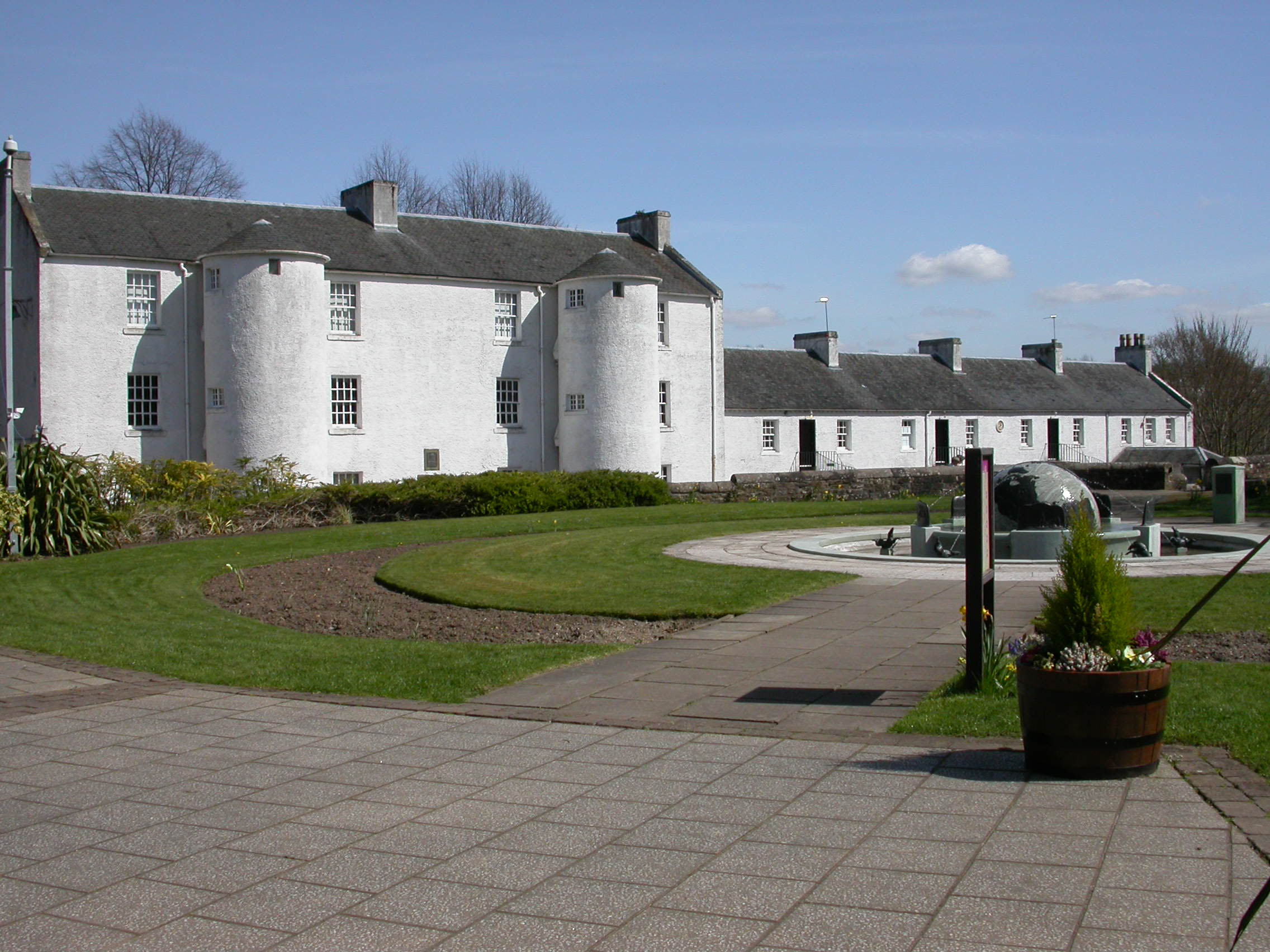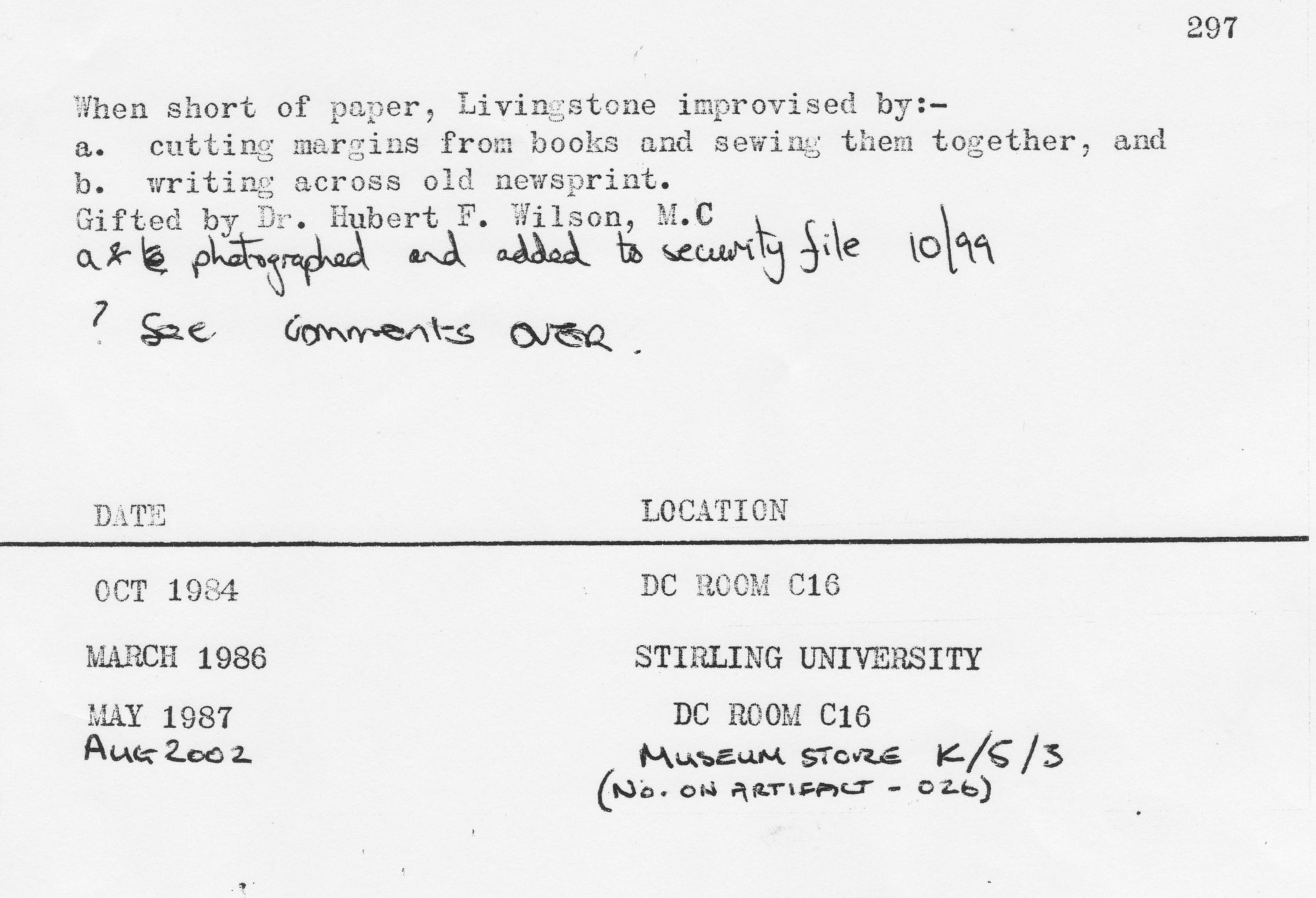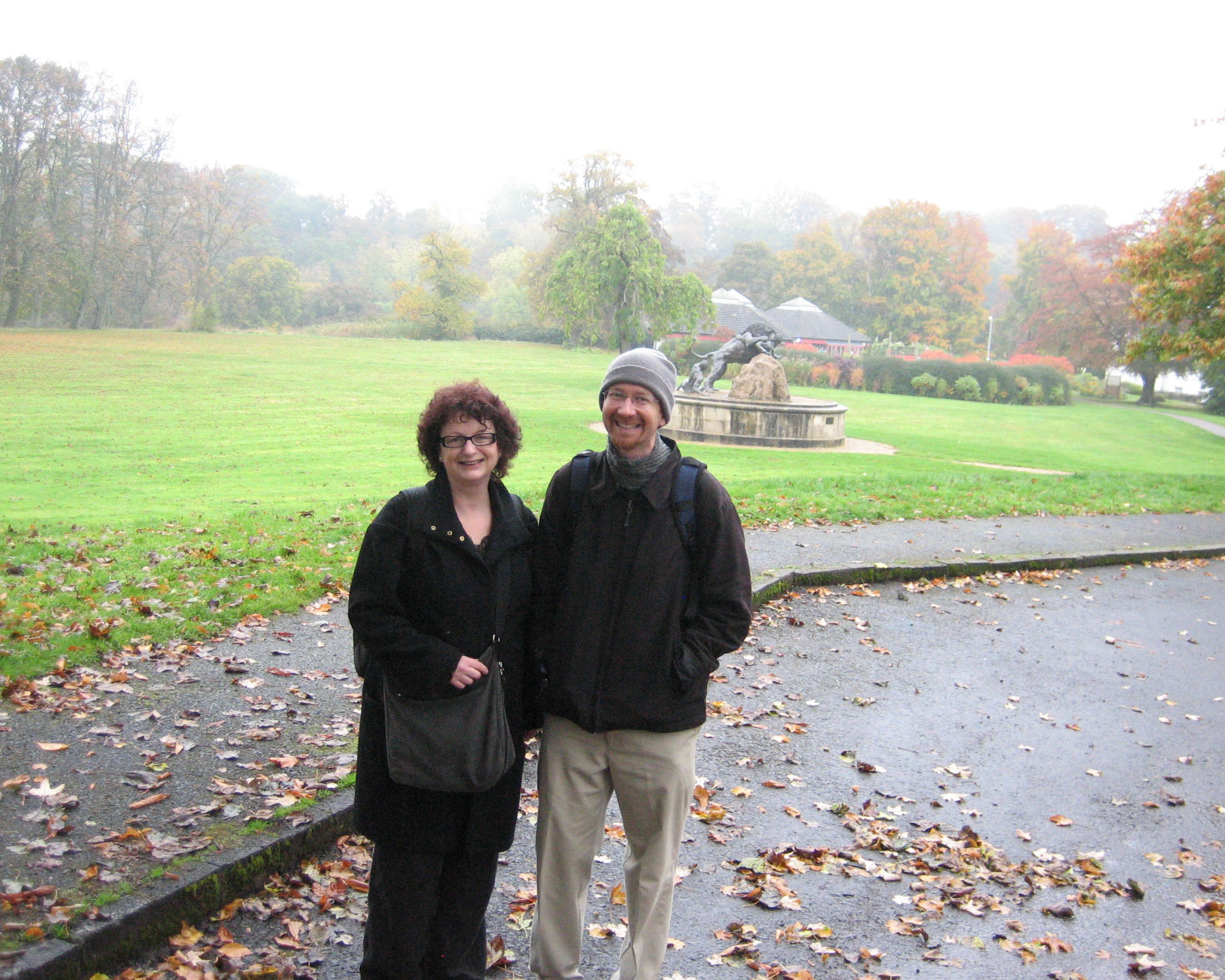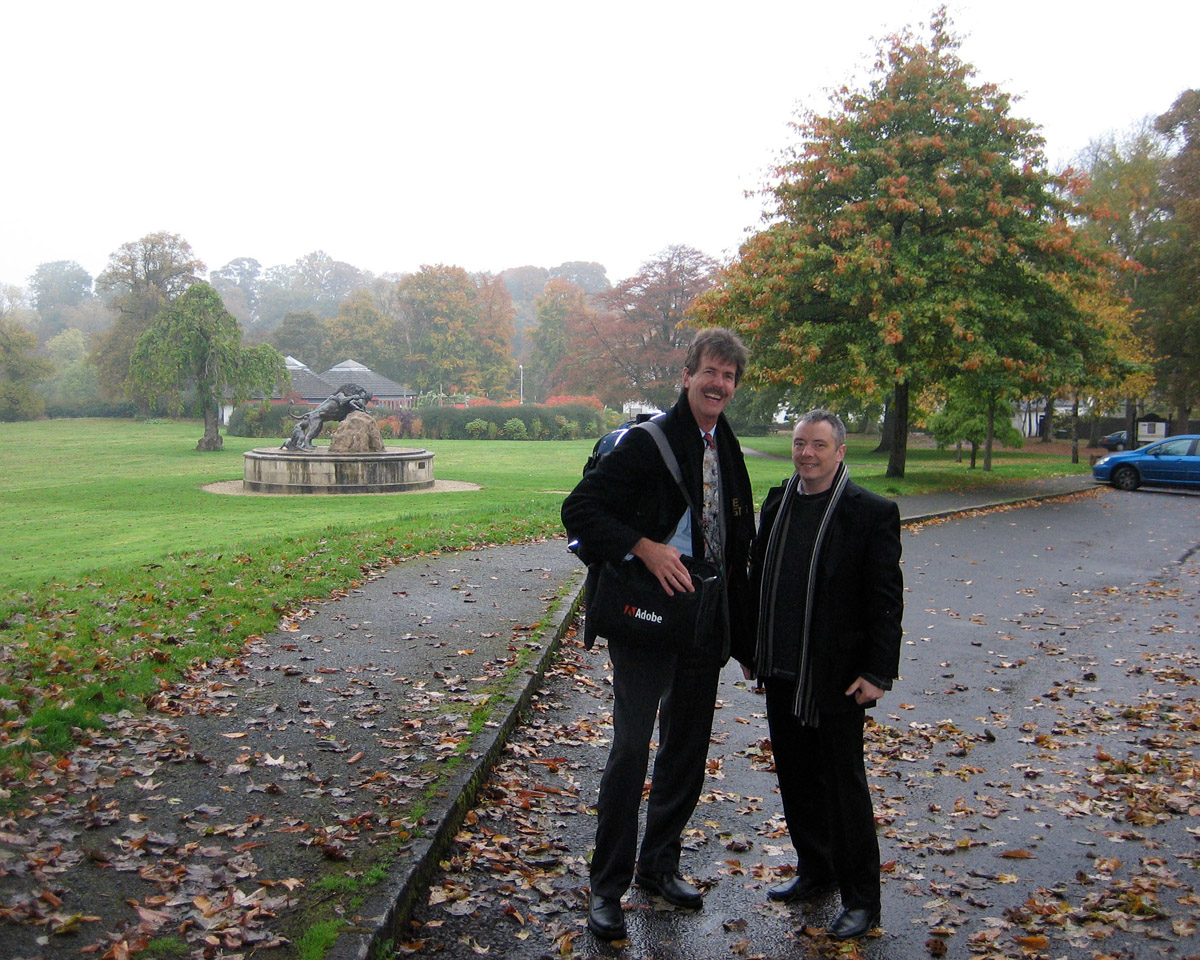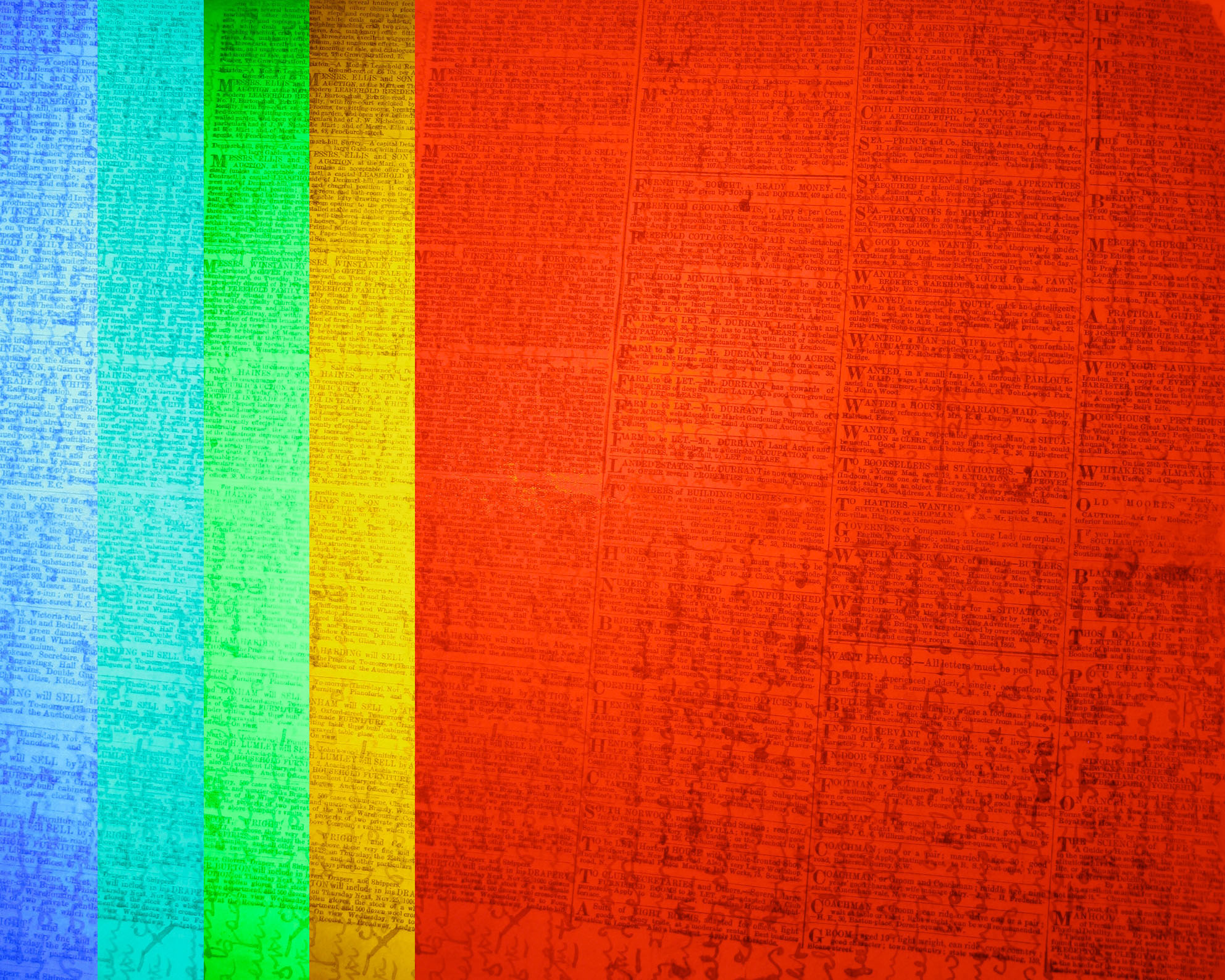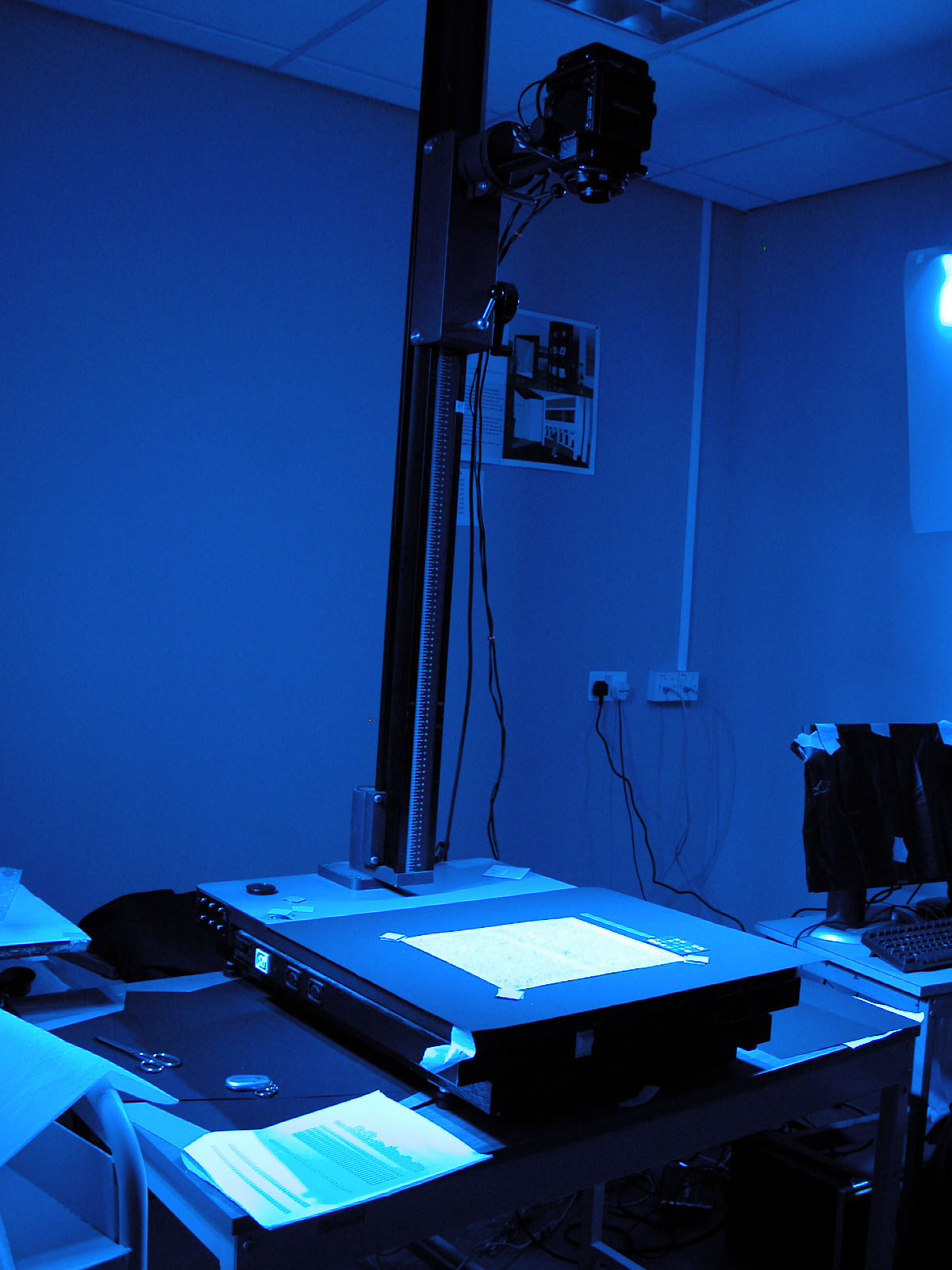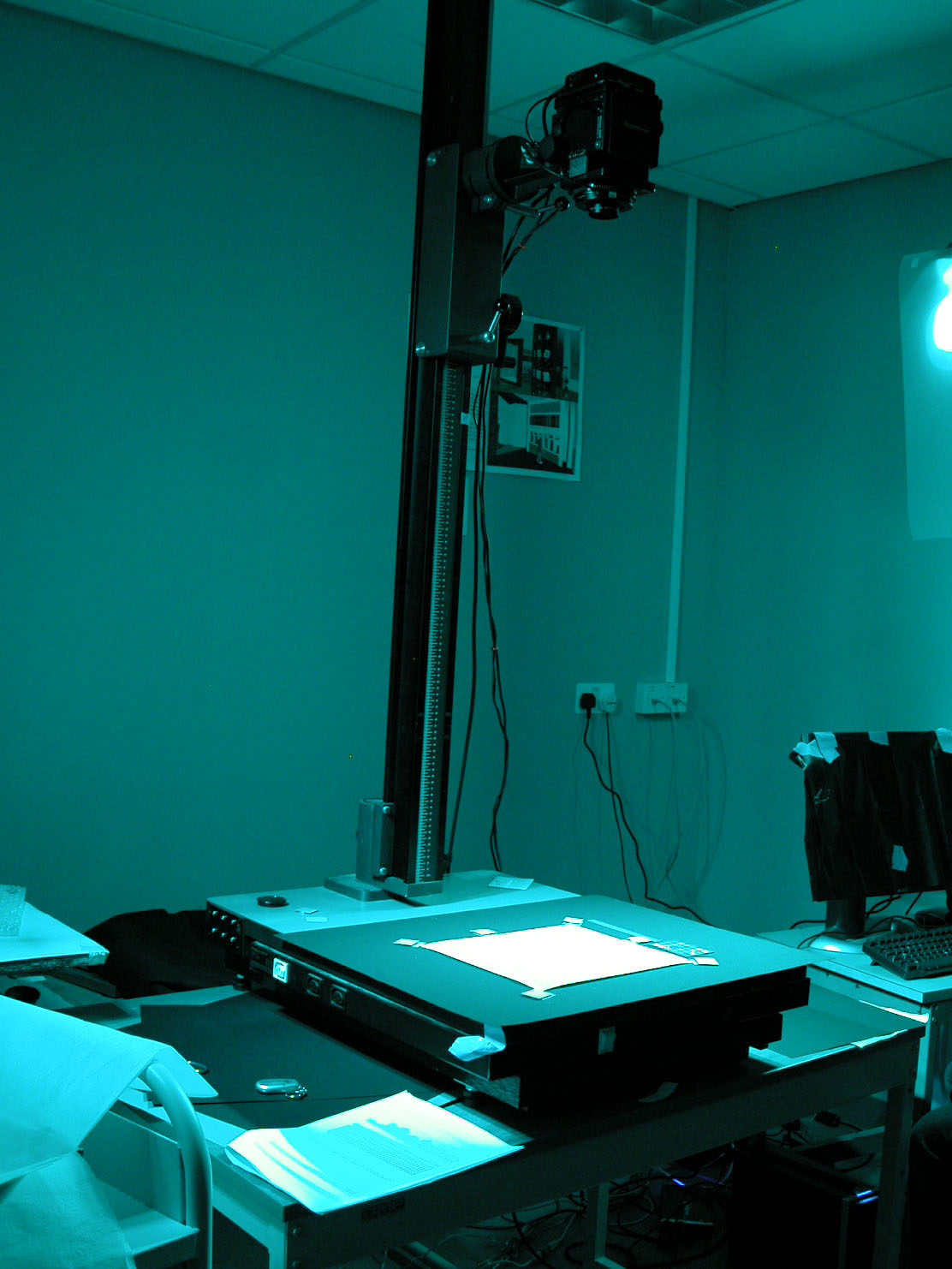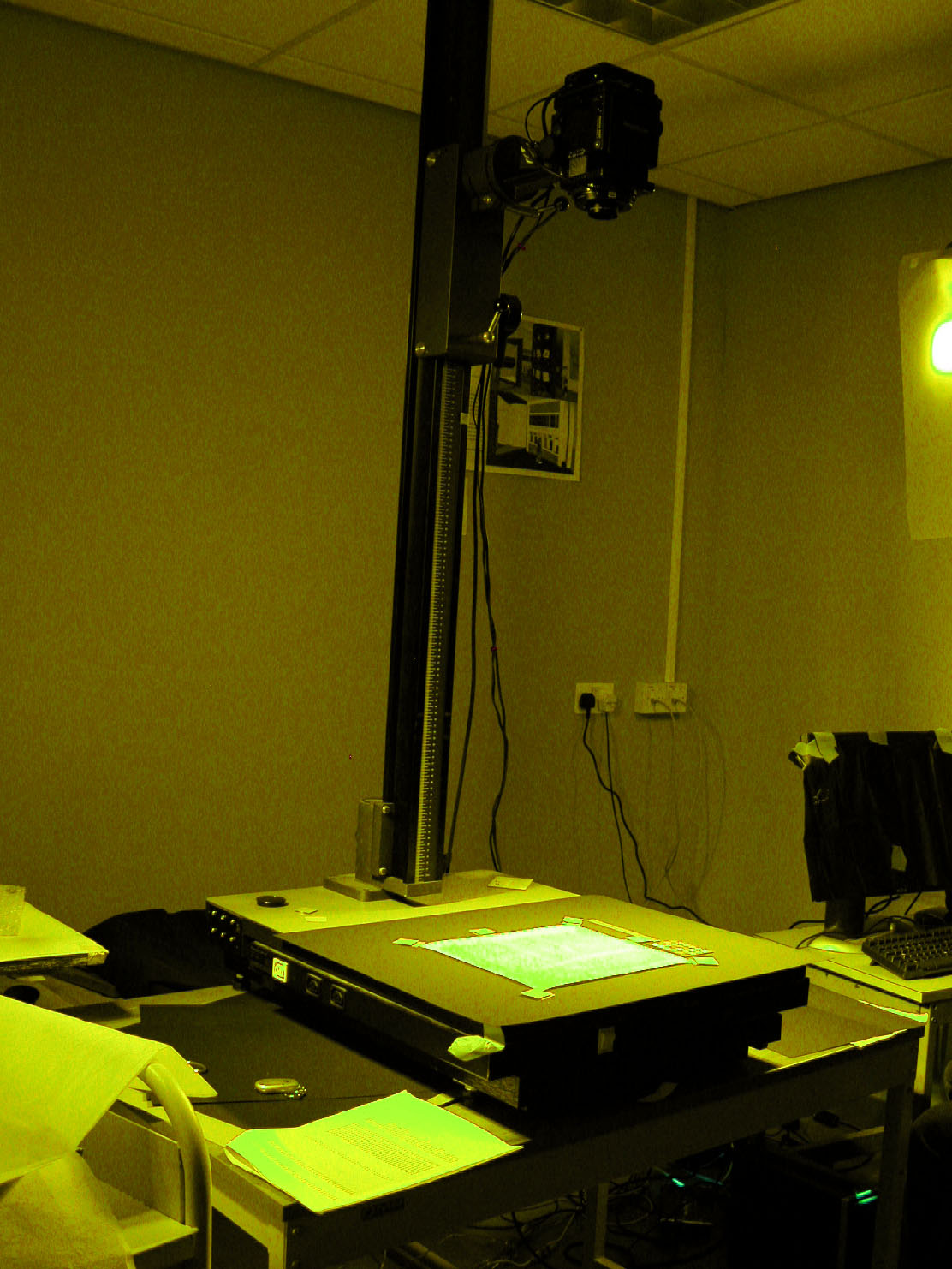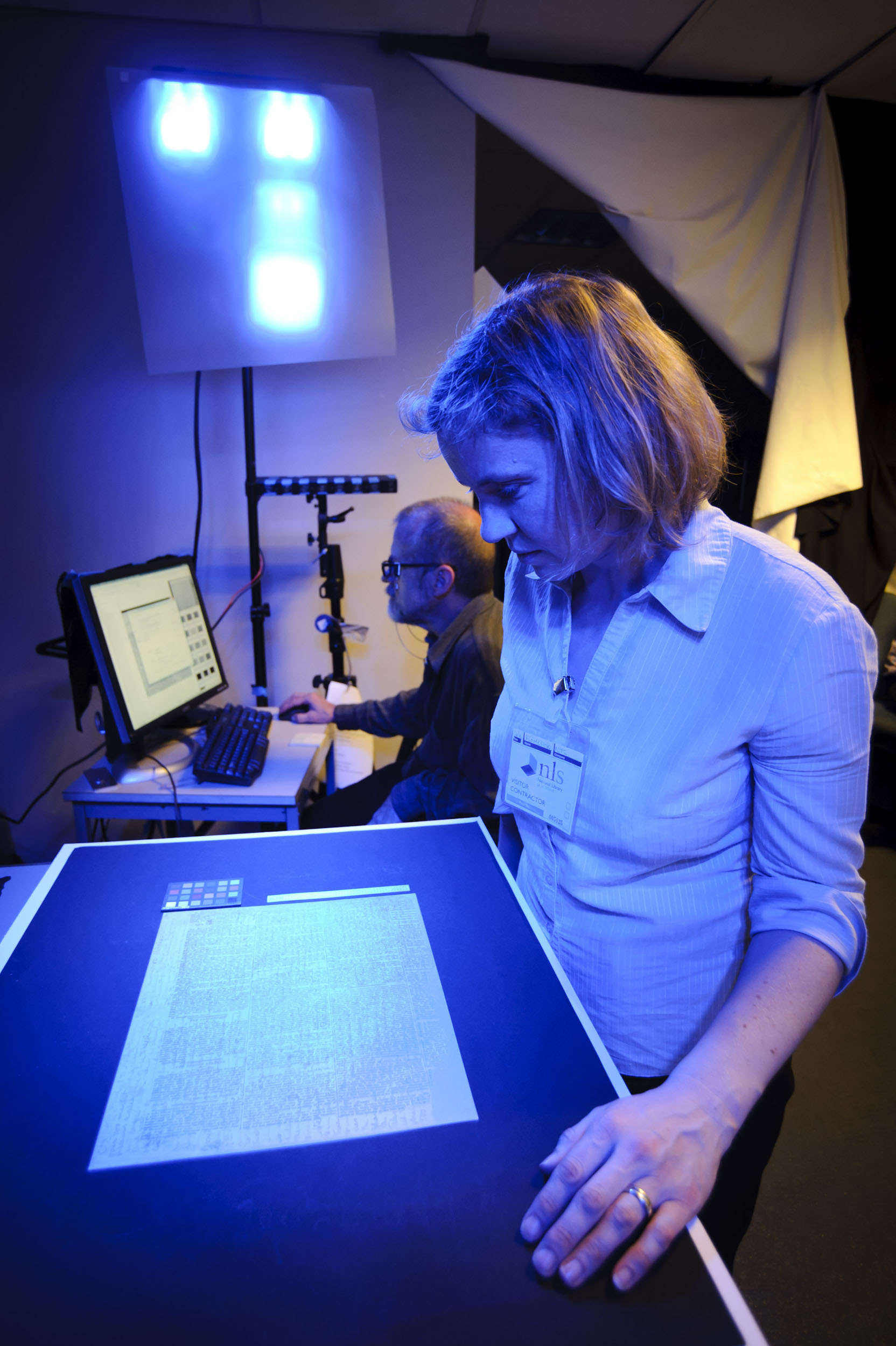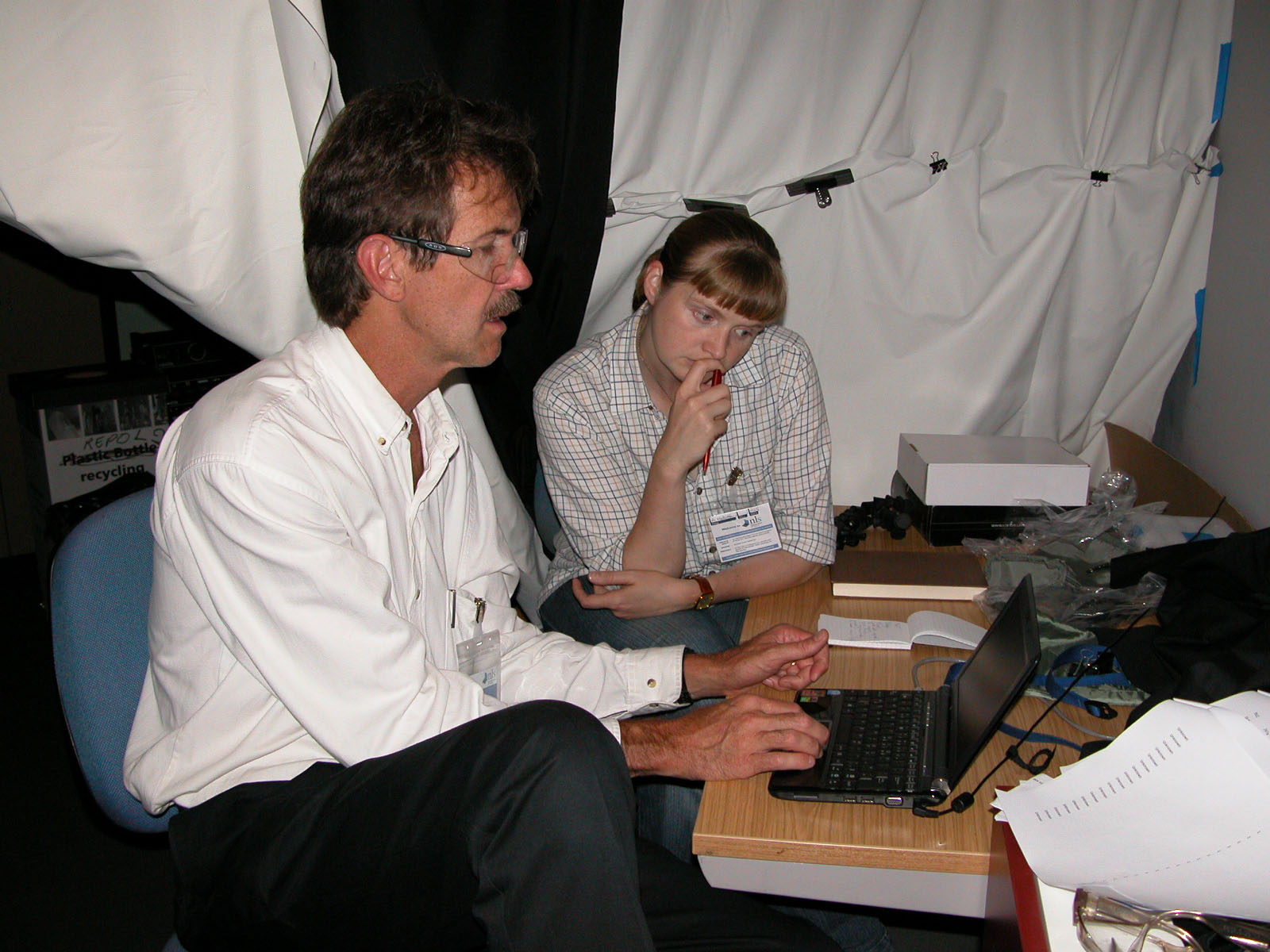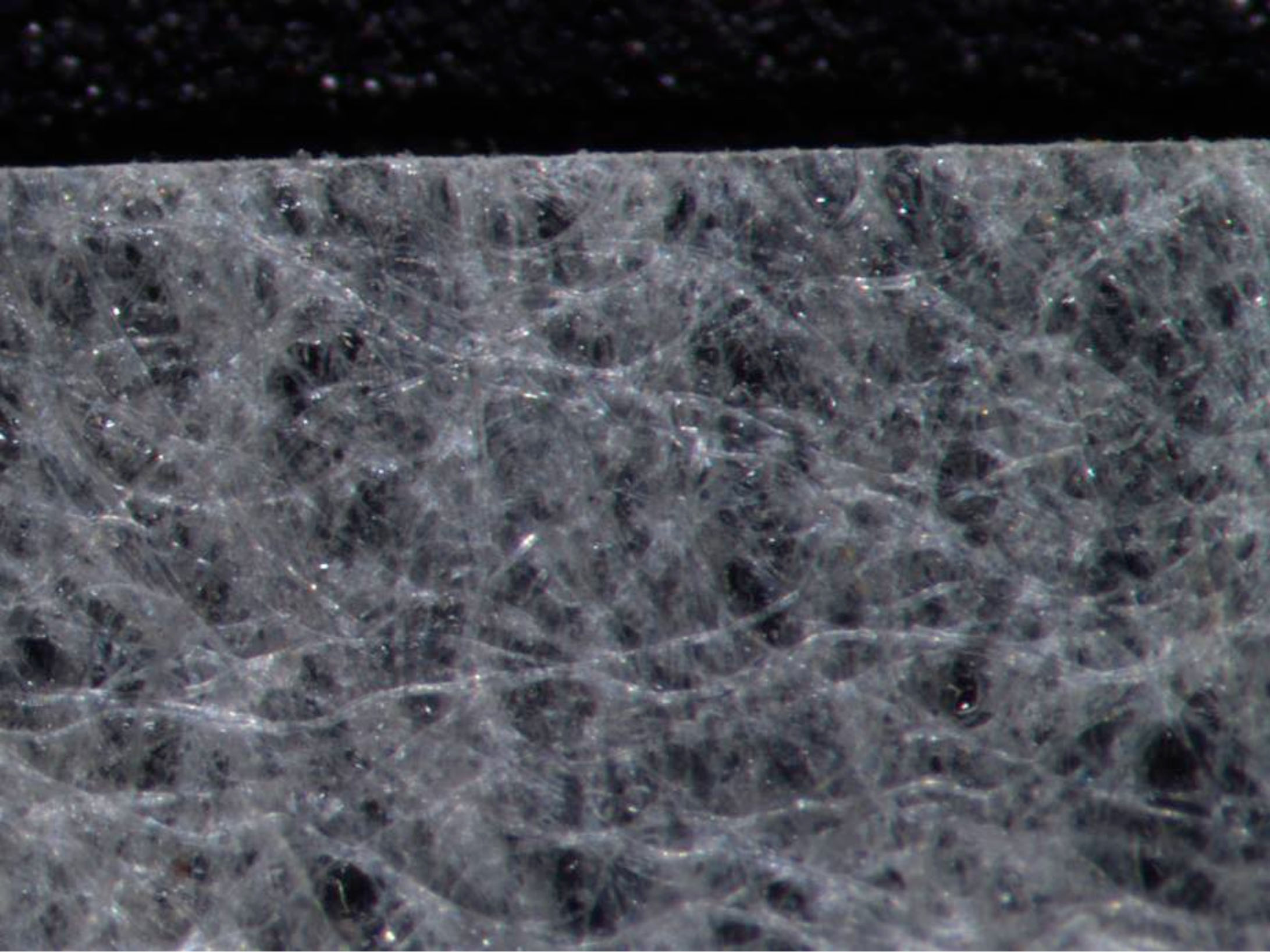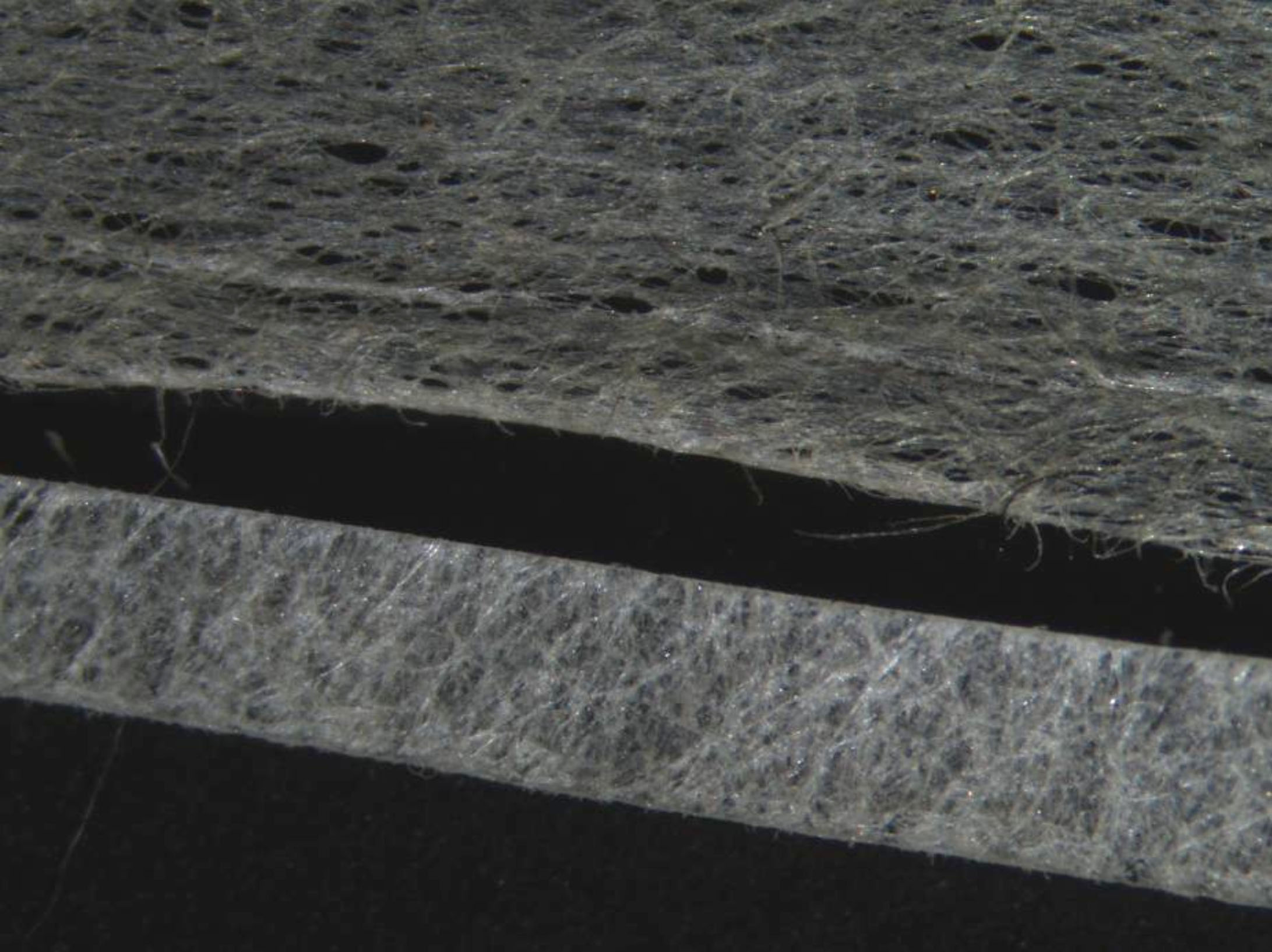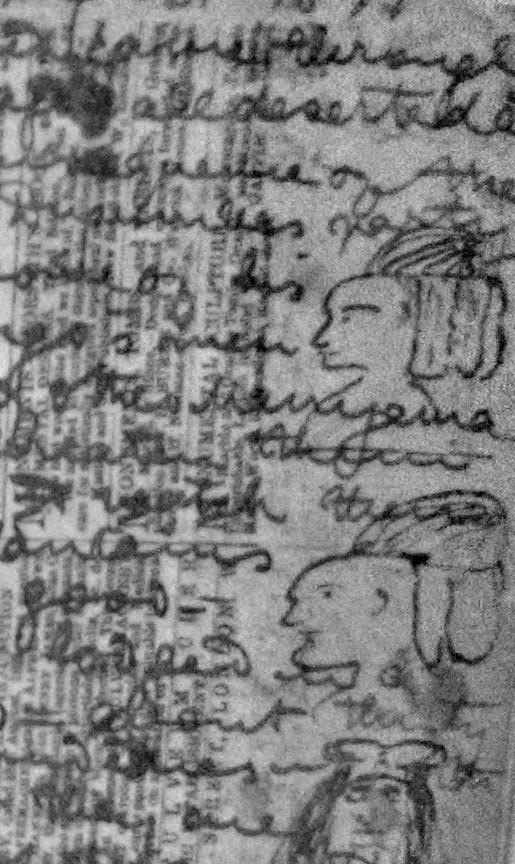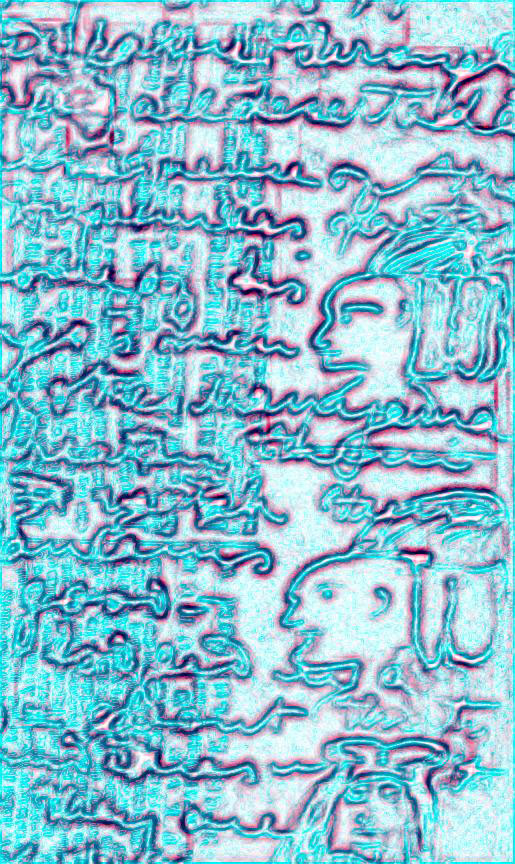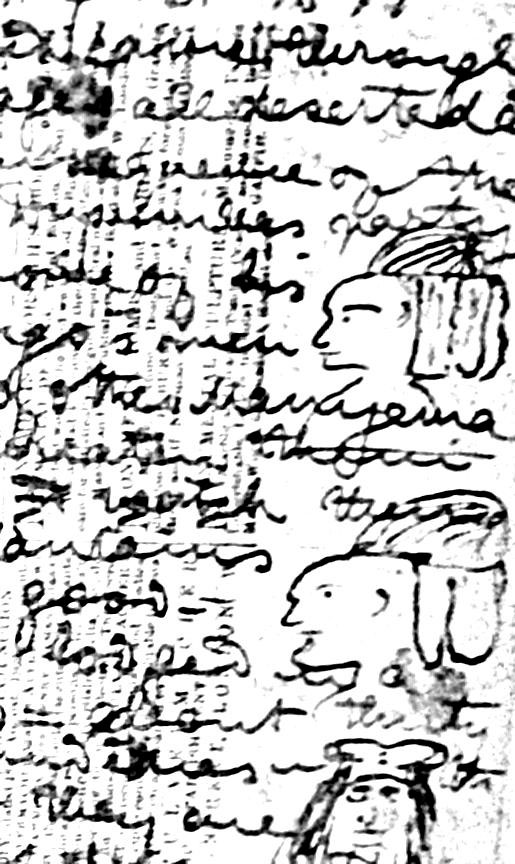Project History (1)
Cite page (MLA): Wisnicki, Adrian S. "Project History (1)." Debbie Harrison, ed. In Livingstone's 1871 Field Diary. Adrian S. Wisnicki, dir. Livingstone Online. Adrian S. Wisnicki and Megan Ward, dirs. University of Maryland Libraries, 2017. Web. http://livingstoneonline.org/uuid/node/d2c119f4-4ada-4b18-9aca-6e79a46dc975.
This page, the first part of a two-part essay, sets out the history of our work to develop a multispectral critical edition of Livingstone’s 1871 Field Diary. The two-part essay provides an overview of all significant phases of project endeavor and for each phase describes all key project activities. (Note: Contemporaneous institutional affiliations for individuals have been retained although some of these have since changed.) Read the second part of the essay here.
Introduction Top⤴
This page, the first part of a two-part essay, sets out the history of our work to develop a multispectral critical edition of Livingstone’s 1871 Field Diary and complements the documentation related to the development of our critical edition. In doing so, the essay extends our efforts to conduct publicly-funded research in a transparent manner that promotes knowledge transfer and that opens all aspects of our research to critical review. Read the second part of the essay here.
Initial History Top ⤴
▲ Locating the Manuscript. Adrian S. WisnickiAdrian S. Wisnicki (Indiana University of Pennsylvania). Director, lead scholar, and principal writer for the multispectral critical edition of Livingstone's 1871 Field Diary. first took interest in the manuscript of Livingstone’s 1871 Field Diary while researching a book chapter on Victorian travel to Nyangwe, the village in which Livingstone wrote most of the diary. The Livingstone Catalogue of Documents (Clendennen and Cunningham 1979) placed the manuscript in the John Murray Archive in London, but further enquiries revealed that the National Library of Scotland (NLS), which now owns the Murray Archive, had only low-quality photocopies of the manuscript made in the 1970s.

(Top) The David Livingstone Centre, Blantyre, 2010. Courtesy of the David Livingstone Centre. (Bottom) The National Library of Scotland, Edinburgh, 2010. Courtesy of the National Library of Scotland.
The Catalogue also noted that the museum based at Livingstone’s childhood home in Blantyre, the Scottish National Memorial to David Livingstone (also known as the David Livingstone Centre [DLC]), had previously owned the manuscript. As a result, WisnickiAdrian S. Wisnicki (Indiana University of Pennsylvania). Director, lead scholar, and principal writer for the multispectral critical edition of Livingstone's 1871 Field Diary. next visited the DLC in June 2009 and – thanks to the efforts of Anne MartinAnne Martin (David Livingstone Centre). Institutional contact for the multispectral critical edition of Livingstone's 1871 Field Diary., volunteer archivist at the DLC – located the second half of the manuscript, those pages held under DLC identifier 297b. The whereabouts of the remaining pages remained a mystery. Wisnicki also discovered that the manuscript was illegible, with only some 15% of Livingstone’s text being visible. Livingstone's improvised ink had faded, while the newsprint over which he had written remained prominent, thereby obscuring the handwritten text. Despite these issues, Wisnicki had a hunch that the text could be recovered.
Download a set of curated Locating the Manuscript project documents
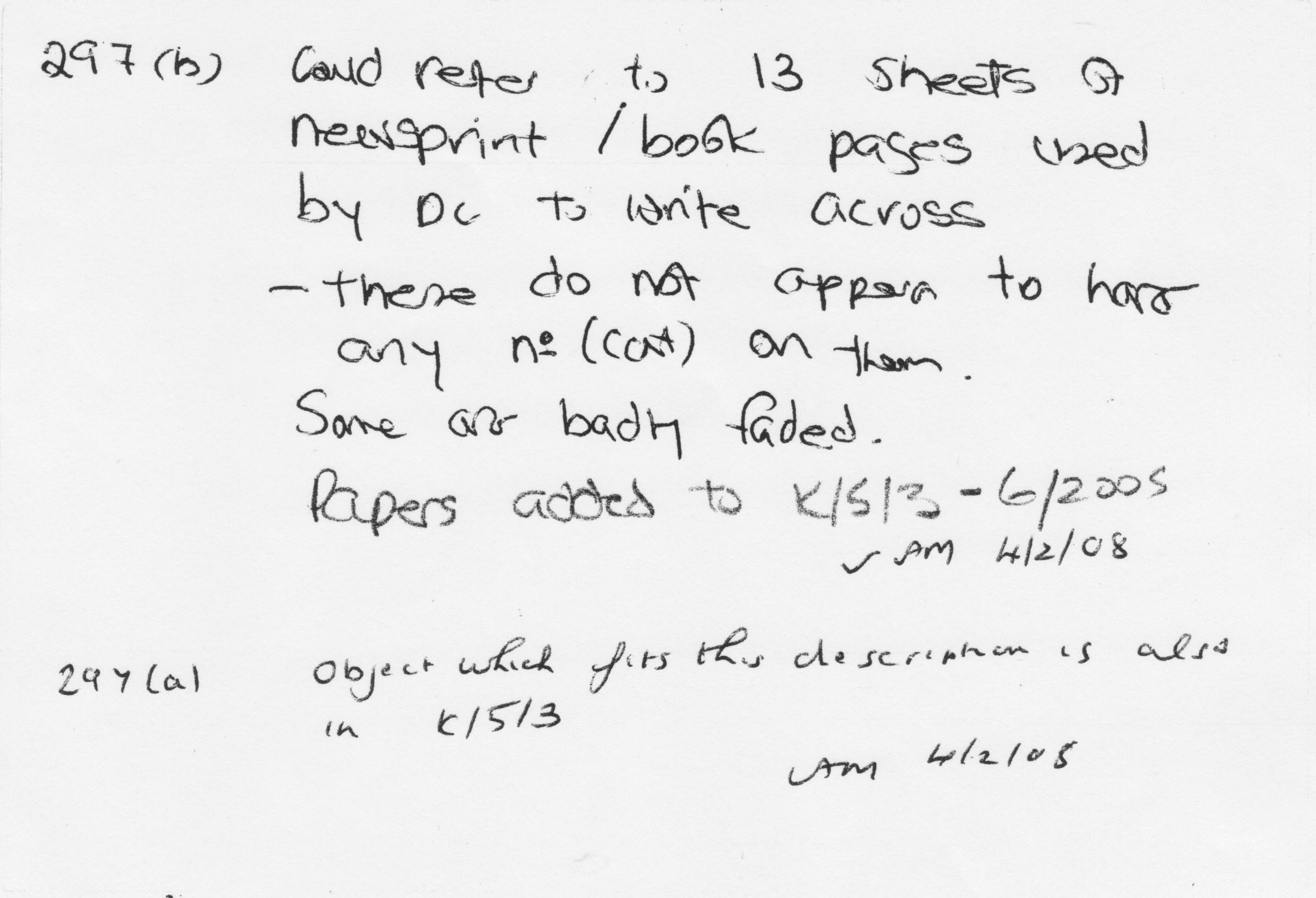
David Livingstone Centre card index entry 297a and 297b (recto: top; verso: bottom), 2008. Copyright David Livingstone Centre. Object images used by permission. May not be reproduced without the express written consent of the National Trust for Scotland, on behalf of the Scottish National Memorial to David Livingstone Trust. Creative Commons Attribution-NonCommercial 3.0 Unported
▲ Contacting the Archimedes Team / Visit to Blantyre. WisnickiAdrian S. Wisnicki (Indiana University of Pennsylvania). Director, lead scholar, and principal writer for the multispectral critical edition of Livingstone's 1871 Field Diary. queried SHARP-L, the listserv of the Society for the History of Authorship, Reading, and Publishing, and asked for help in reading the Livingstone’s writing. The email caught the attention of Will Noel, then Curator of Manuscripts at the Walters Art Museum in Baltimore, Maryland. Noel forwarded Wisnicki’s email to the Archimedes Palimpsest spectral imaging team who then contacted Wisnicki. The Archimedes imaging team took interest in the diary because it offered the opportunity to apply spectral imaging and processing techniques developed to study older, parchment-based palimpsests to a more modern, paper-based document. Christopher Lawrence, then director of Livingstone Online, encouraged such a collaborative project and offered to publish the results through his site.

(Top) Home page of the Archimedes Palimpsest Project, 2017. Copyright Archimedes Palimpsest Project. Creative Commons Attribution-NonCommercial 3.0 Unported. (Bottom) Home page of Livingstone Online, circa 2008-13. Copyright Livingstone Online. Creative Commons Attribution-NonCommercial 3.0 Unported
As a result, two representatives of the Archimedes imaging team, program manager Michael B. TothMichael B. Toth (R.B. Toth Associates). Program manager for the multispectral critical edition of Livingstone's 1871 Field Diary. and data manager Doug EmeryDoug Emery (Emery IT). Data manager for the multispectral critical edition of Livingstone's 1871 Field Diary., joined WisnickiAdrian S. Wisnicki (Indiana University of Pennsylvania). Director, lead scholar, and principal writer for the multispectral critical edition of Livingstone's 1871 Field Diary., Debbie HarrisonDebbie Harrison (Birkbeck, University of London). Contributing editor and outreach director for the multispectral critical edition of Livingstone's 1871 Field Diary. (medical humanities specialist and Wisnicki’s colleague at Birkbeck College), and Sharon Messenger (then research assistant at Livingstone Online) in visiting the DLC in mid October 2009. The group met with representatives of the DLC, including trustees, staff, and representatives from the National Trust for Scotland (NTS), to discuss the project and view the manuscript.
The group took a small sample of the laminate used on the manuscript leaves for assessment at the U.S. Library of Congress and comparison with other spectrally imaged laminated documents. The group also collected some sample spectral images of a few leaves to validate the potential of spectral imaging to reveal Livingstone’s text. They collected the images in a darkened room by using a small 5 MegaPixel color camera taped to an overhead projector arm and a handheld light source with UV, red, green, yellow and blue lights.
| (First row left; top in mobile) Debbie Harrison and Adrian S. Wisnicki on the grounds of the David Livingstone Centre, 2009. (First row right; second down in mobile) Michael B. Toth and Doug Emery on the grounds of the David Livingstone Centre, 2009. (Second row left; third down in mobile) Doug Emery and Stuart Whittaker at the David Livingstone Centre, 2009. (Second row right; bottom in mobile) Montage of low-tech spectral images of a page of the 1871 Field Diary. (First, second, and third images) Copyright Livingstone Spectral Imaging Project team. (Fourth image) Copyright David Livingstone Centre, Blantyre. As relevant, copyright Dr. Neil Imray Livingstone Wilson. (All images) Creative Commons Attribution-NonCommercial 3.0 Unported. |
▲ Funding and the Missing Diary Pages. Initial contact between WisnickiAdrian S. Wisnicki (Indiana University of Pennsylvania). Director, lead scholar, and principal writer for the multispectral critical edition of Livingstone's 1871 Field Diary. (residing first in London, then New York City, and, later, Indiana, Pennsylvania) and HarrisonDebbie Harrison (Birkbeck, University of London). Contributing editor and outreach director for the multispectral critical edition of Livingstone's 1871 Field Diary. (London), and the Archimedes imaging team (Washington, D.C.; Baltimore, Maryland; Rochester, New York; Maui, Hawaii) resulted in extensive follow-up discussion by telephone, Skype, and email regarding a possible collaboration. The group also decided to apply to the U.S. National Endowment for the Humanities (NEH) for a Digital Humanities Start-Up Grant. Mike Phelps, Executive Director of the Early Manuscripts Electronic Library, offered to have his organization serve as the grantee organization and himself as administrator, and the team submitted a formal application to the NEH on 6 October 2009. The team also submitted an application to the British Academy for a Small Research Grant on 20 February 2010.
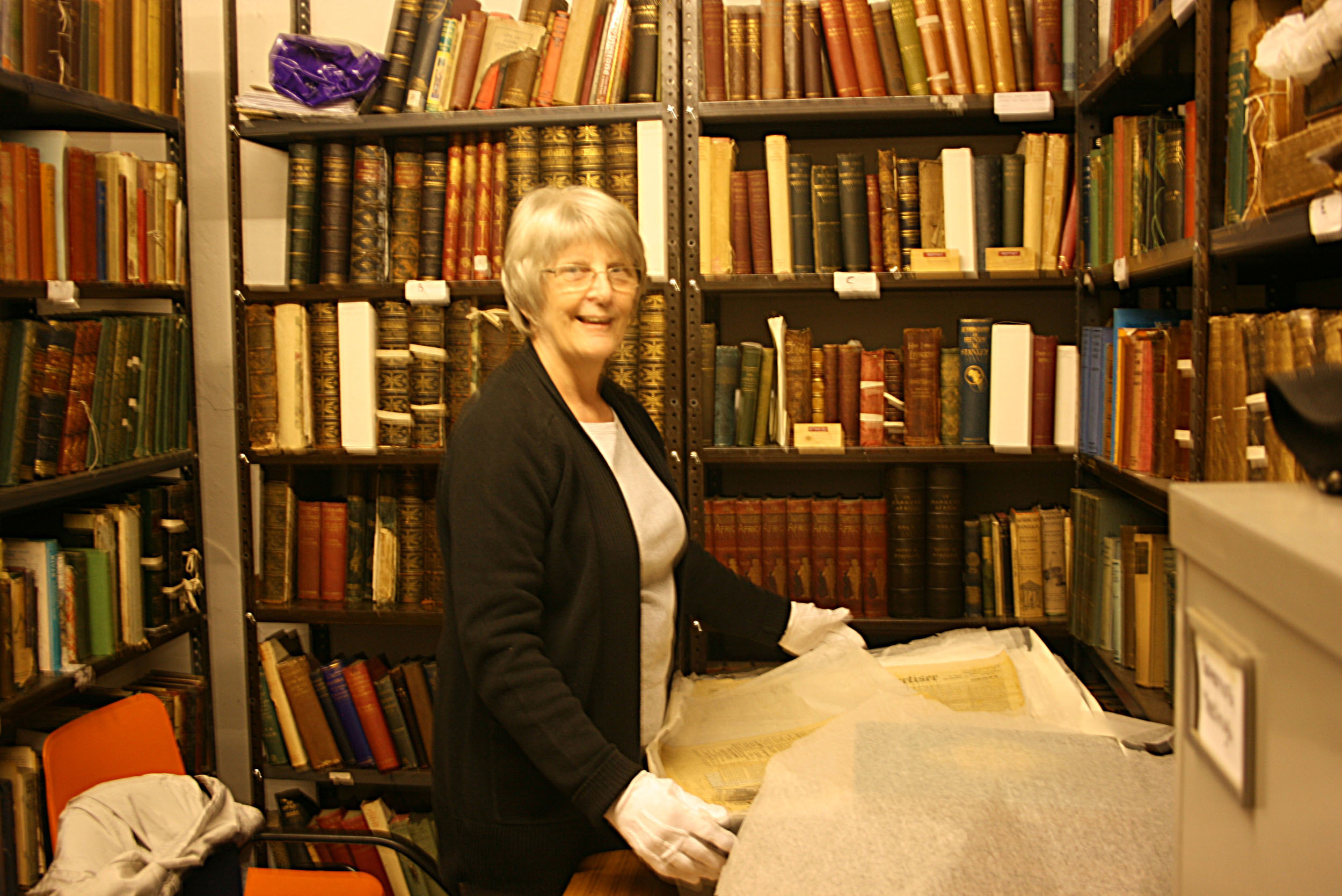
Anne Martin with the 1871 Field Diary in the David Livingstone Centre archives, 2011. Copyright Livingstone Spectral Imaging Project team. Creative Commons Attribution-NonCommercial 3.0 Unported
During late 2009 and early 2010, MartinAnne Martin (David Livingstone Centre). Institutional contact for the multispectral critical edition of Livingstone's 1871 Field Diary. continued her efforts at the DLC in locating the remaining pages of the 1871 Field Diary. The pages had not been catalogued properly, but Martin’s perseverance resulted not only in the rediscovery of the missing pages (those now under DLC identifier 297c) but also in the recovery of several pages of Livingstone's 1870 Field Diary, which she and WisnickiAdrian S. Wisnicki (Indiana University of Pennsylvania). Director, lead scholar, and principal writer for the multispectral critical edition of Livingstone's 1871 Field Diary. had not been able to locate during Wisnicki’s initial visit to Blantyre in June 2009 (the pages now under 297d and 297e).
Download a set of curated Project Funding project documents
▲ Livingstone’s Letter from Bambarre. Simultaneously, in late 2009 Elizabeth Upper, a graduate student of Cambridge University, contacted Livingstone Online on behalf of Peter Beard, the American photographer. Beard and his wife Nejma offered to make available for study a previously unpublished Livingstone letter from their personal collection in New York City. By a striking coincidence, Livingstone had composed this letter during the same period as the 1870 and 1871 Field Diaries, using the same improvised techniques.
More fortuitously still, WisnickiAdrian S. Wisnicki (Indiana University of Pennsylvania). Director, lead scholar, and principal writer for the multispectral critical edition of Livingstone's 1871 Field Diary., who was then a research consultant for Livingstone Online, had himself just moved to New York City and was residing a mere 8 miles away from the letter. Wisnicki visited the Peter Beard Studio to view the letter and eventually arranged for its transport to the Walters Art Museum, where the letter was spectrally imaged in early 2010 during a separately funded palimpsest imaging project. On 2 July 2010, the team formally announced the start up of The David Livingstone Spectral Imaging Project with the publication of this letter in a multispectral critical edition as Livingstone's Letter from Bambarre. That edition then became the prototype and template for the current critical edition.
Pre-Imaging Activities Top ⤴
▲ Setting the Stage. The U.S. National Endowment for the Humanities (NEH) formally awarded the Livingstone team a Digital Humanities Start-Up Grant on 11 March 2010. The team’s grant application set the start date as 1 May 2010. Planning for the project began with the drafting of the grant application, but serious plans could not go forward until this grant announcement.
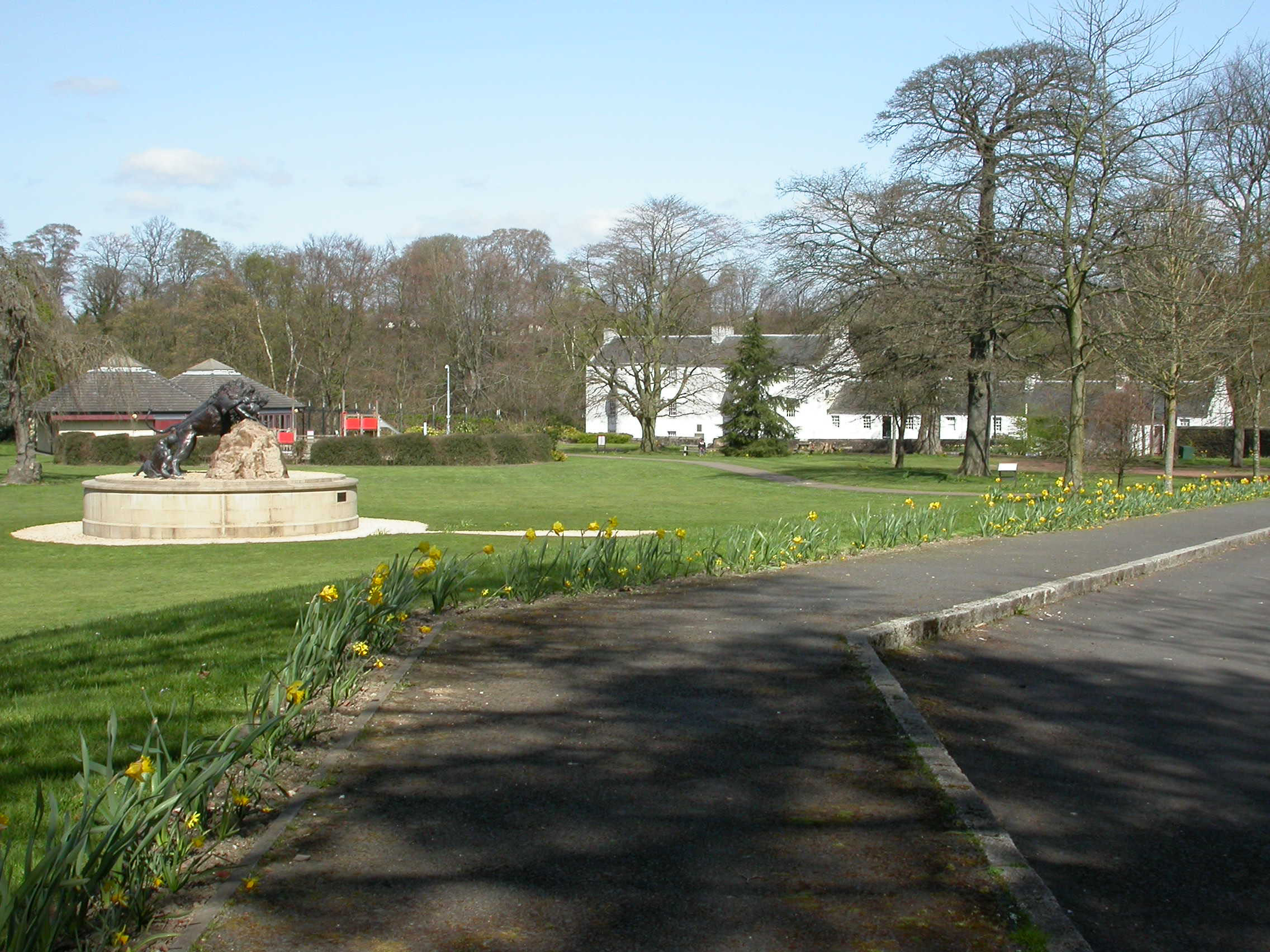
The David Livingstone Centre, Blantyre, 2010. Courtesy of the David Livingstone Centre.
The team decided to travel to Scotland for the spectral imaging of Livingstone’s manuscript in mid-June 2010. This travel date necessitated that preparations begin from the moment of the announcement. The trustees of the David Livingstone Centre (DLC) had given the team preliminary permission for the project, but full written permission had now to be secured. A conservator would have to examine the manuscript and prepare it for imaging. The team had to select a site for the spectral imaging that met the technical requirements of the project. Finally, the team also needed to prepare a detailed imaging plan that included a Statement of Work (SOW) agreed on by all stakeholders, conduct a site survey, and secure the support of appropriate local personnel.
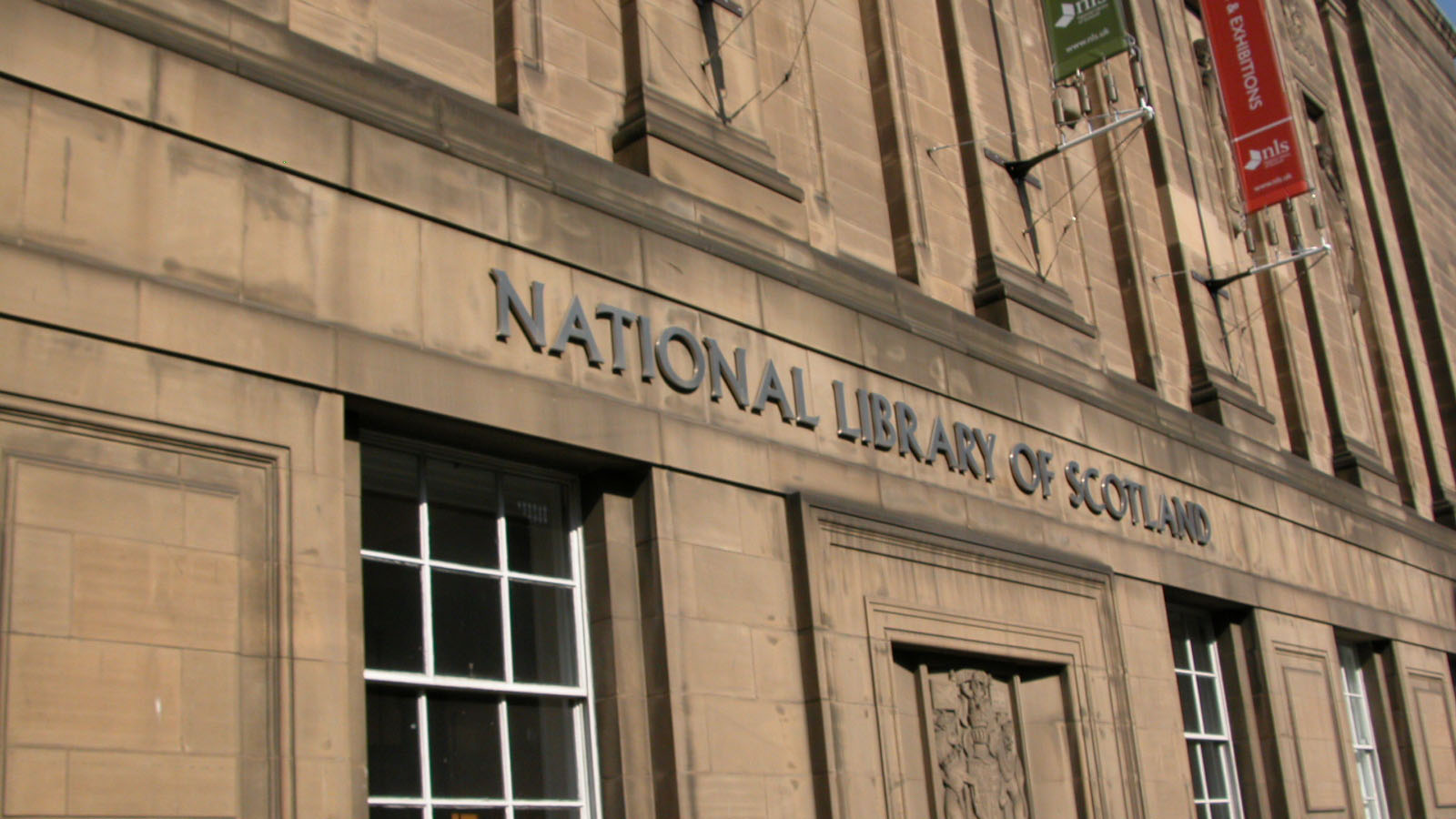
The National Library of Scotland, Edinburgh, 2010. Courtesy of the National Library of Scotland.
After discussion with the DLC staff, the Livingstone team decided to carry out the imaging at a second site. The National Library of Scotland (NLS), being located an hour by car from the DLC, offered the perfect alternative. WisnickiAdrian S. Wisnicki (Indiana University of Pennsylvania). Director, lead scholar, and principal writer for the multispectral critical edition of Livingstone's 1871 Field Diary. had previously discussed the project with Alison MetcalfeAlison Metcalfe (National Library of Scotland). Institutional contact for the multispectral critical edition of Livingstone's 1871 Field Diary., Manuscripts Curator at the National Library of Scotland (NLS), and together Wisnicki and Metcalfe now formalized the role of the NLS as a project partner. There were several advantages to this relationship. The library could provide the facilities and personnel needed to adequately support the project, and the library holds the largest number of Livingstone materials in the world. Should the imaging run ahead of schedule, Livingstone materials from the NLS could be spectrally imaged without added cost.
▲ Permission and Conservation. With the location secured, WisnickiAdrian S. Wisnicki (Indiana University of Pennsylvania). Director, lead scholar, and principal writer for the multispectral critical edition of Livingstone's 1871 Field Diary. now wrote letters to the DLC trustees and the Livingstone family for permission to transport, spectrally image, and digitally publish the relevant materials from the DLC and related materials at the NLS. Neil Imray Livingstone Wilson and Ian Livingstone proved to be very enthusiastic about the project and kindly granted permission on behalf of, respectively, the Livingstone family and the DLC trustees.
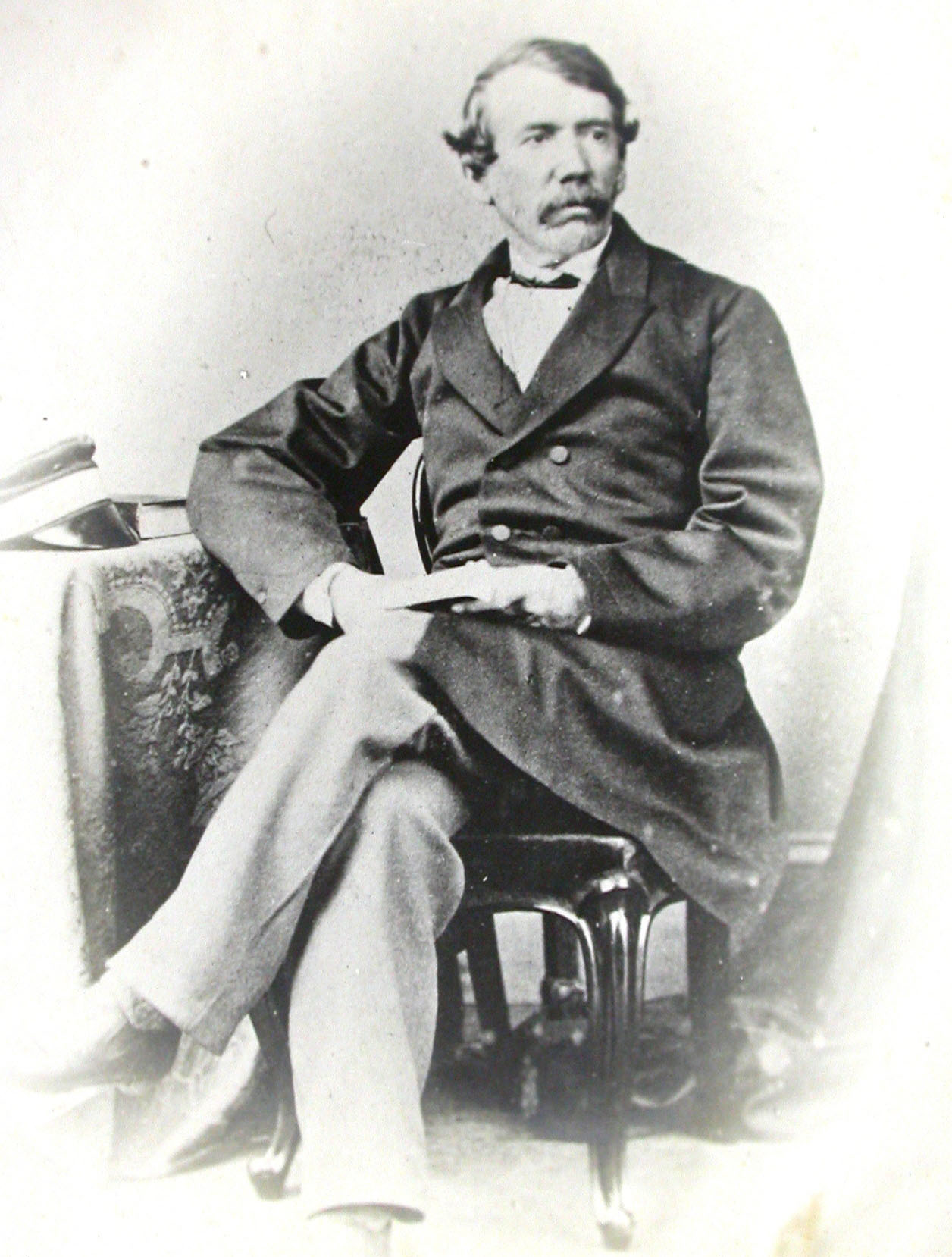
Photograph of David Livingstone, 1857. Copyright David Livingstone Centre. Object images used by permission. May not be reproduced without the express written consent of the National Trust for Scotland, on behalf of the Scottish National Memorial to David Livingstone Trust.
The National Trust for Scotland, in turn, arranged for Helen Creasy, Paper and Photograph Conservator at the Scottish Conservation Studio, to prepare the DLC materials for imaging, an activity covered by the team’s NEH grant. Creasy’s work included stabilizing documents for handling, repairing all edge tears and tears along central fold lines, reattaching a detached page, and supporting manuscript weaknesses using very light-weight Japanese tissue and wheat starch paste. She also photographed the documents before and after treatment, and secured and packed them for transportation. Kate Kidd, conservator at the NLS, evaluated the related NLS materials and found that they needed only minimal conservation, which the NLS provided pro bono.
Download a set of curated Conservation project documents
▲ Project Planning. Project planning took up the majority of time prior to the team’s departure for Scotland. Michael B. TothMichael B. Toth (R.B. Toth Associates). Program manager for the multispectral critical edition of Livingstone's 1871 Field Diary., program manager for the Livingstone project, supervised this planning with strategic support from WisnickiAdrian S. Wisnicki (Indiana University of Pennsylvania). Director, lead scholar, and principal writer for the multispectral critical edition of Livingstone's 1871 Field Diary., MetcalfeAlison Metcalfe (National Library of Scotland). Institutional contact for the multispectral critical edition of Livingstone's 1871 Field Diary., Robert Jackson (Preservation and Conservation Manager at the NLS), and other team members. Toth’s work included developing a detailed imaging plan that outlined 1) an Assessment and Pilot Phase, 2) a Planning Phase, 3) an Imaging and Processing Phase, and 4) a Data Management Phase. Toth broke up each of these phases into discrete tasks, determined how many days would be required for each, and allocated work accordingly. Toth also prepared a series of documents for team members that foregrounded the relationships between the different tasks.
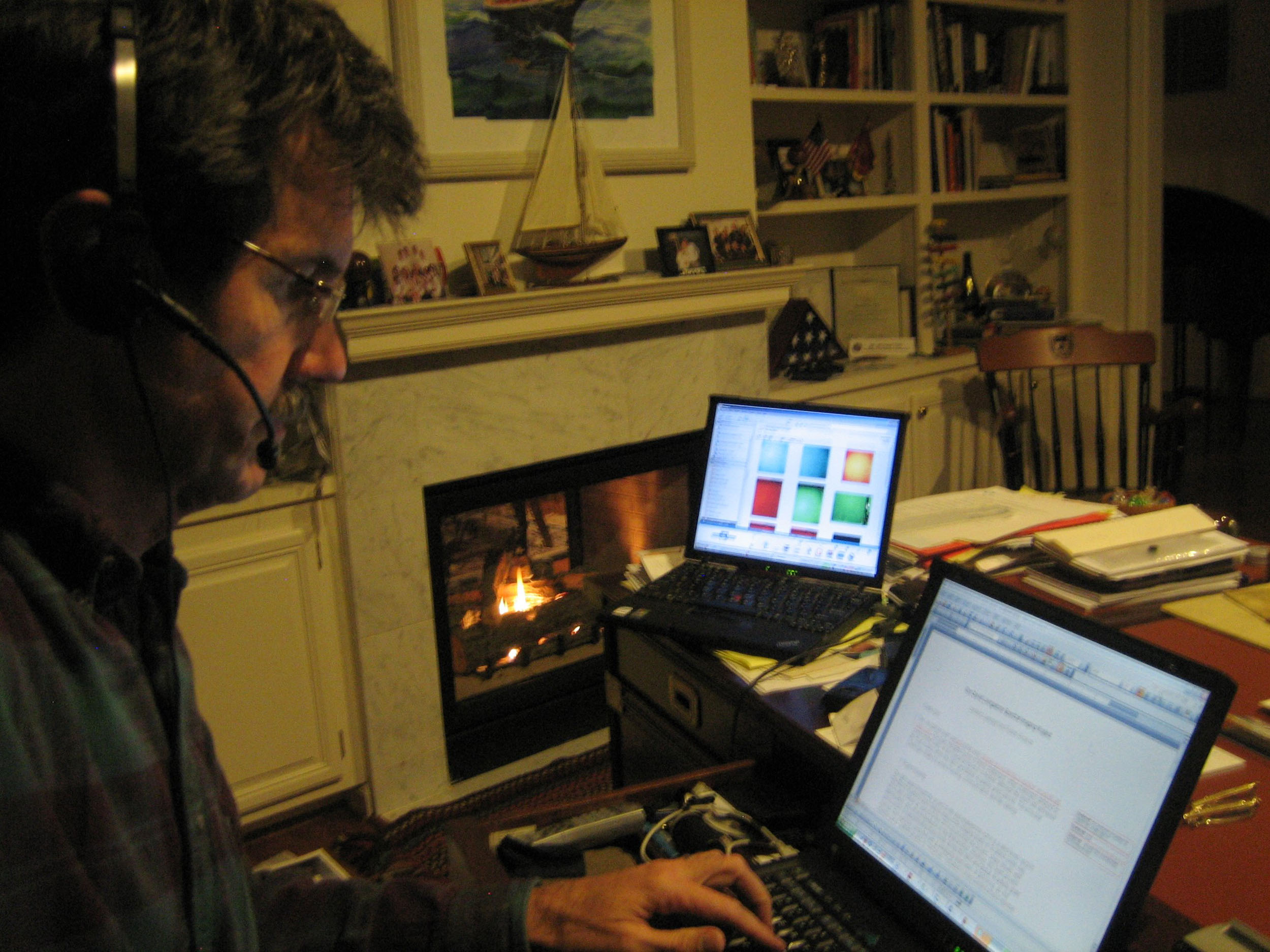
Michael B. Toth while directing one the Livingstone Spectral Imaging Project team teleconferences, 2010-2011. Copyright Livingstone Spectral Imaging Project team. Creative Commons Attribution-NonCommercial 3.0 Unported
Alongside this work, TothMichael B. Toth (R.B. Toth Associates). Program manager for the multispectral critical edition of Livingstone's 1871 Field Diary. explored available imaging options. He circulated documents that detailed imaging schedule and on-site processing possibilities, and that highlighted potential issues. A follow-up imaging draft plan enumerated the specific pages to be imaged, proposed a day-by-day imaging schedule, and sketched a data delivery schedule. Toth also used email, phone calls, and teleconferences to coordinate activities between NLS staff, team members traveling from the U.S. to Scotland (WisnickiAdrian S. Wisnicki (Indiana University of Pennsylvania). Director, lead scholar, and principal writer for the multispectral critical edition of Livingstone's 1871 Field Diary., Bill Christens-BarryBill Christens-Barry (Equipoise Imaging, LLC). Imaging scientist for the multispectral critical edition of Livingstone's 1871 Field Diary., Roger L. Easton, Jr.Roger L. Easton, Jr. (Rochester Institute of Technology). Imaging scientist for the multispectral critical edition of Livingstone's 1871 Field Diary., and Ken BoydstonKen Boydston (Megavision, Inc.). Camera engineer for the multispectral critical edition of Livingstone's 1871 Field Diary.), and team members that would provide support from the U.S. (Keith KnoxKeith Knox. Imaging scientist for the multispectral critical edition of Livingstone's 1871 Field Diary., Doug EmeryDoug Emery (Emery IT). Data manager for the multispectral critical edition of Livingstone's 1871 Field Diary.).
These activities culminated in a formal Statement of Work (SOW) that set out:
- Project scope
- Program Management
- Imaging Tasks
- Metadata Preparation
- Deliverable Items
- Key Personnel
- Permissions
- Institutional Requirements
- Schedule
TothMichael B. Toth (R.B. Toth Associates). Program manager for the multispectral critical edition of Livingstone's 1871 Field Diary. developed this document in close collaboration with WisnickiAdrian S. Wisnicki (Indiana University of Pennsylvania). Director, lead scholar, and principal writer for the multispectral critical edition of Livingstone's 1871 Field Diary. and representatives of the NLS. The drafting process served to introduce NLS staff to the rubrics of multispectral imaging and underscored key requirements of the Livingstone team in Scotland, including the need to recruit and train local personnel for basic operation of the imaging system.
Just prior to departure, Toth developed a plan for transporting equipment to Scotland, and created a site survey checklist for team members who intended to visit the NLS in advance of the imaging sessions. In addition, days before the team left, the British Academy announced that it had awarded the team a Small Research Grant, which provided both for an enhanced site survey and helped defray other travel costs.
Download a set of curated Project Planning project documents
Spectral Imaging in Scotland Top ⤴
Spectral imaging, when used for the study of cultural objects, involves illuminating an object with successive wavelengths of light – starting with ultraviolet, working through the visible spectrum, and concluding with infrared – then digitally photographing the resulting illuminations. The produced images all have exactly the same pixel dimensions, and are spatially registered, the content being equivalent at each pixel location in each image. Later, imaging scientists process this data in order to enhance select features of the cultural object.
Learn more about spectral imaging in the related section from Livingstone’s Letter from Bambarre.
| A page of the 1871 Field Diary under six of the twelve illuminations used to spectrally image the diary, 2010. Copyright Livingstone Spectral Imaging Project team. Creative Commons Attribution-NonCommercial 3.0 Unported |
▲ Imaging Set-Up. The Livingstone team spectrally imaged the 1871 Field Diary in the Reprographics Studio at the National Library of Scotland (NLS). The NLS could only allocate about half of the Studio to the team due to the need to support other ongoing activities. As a result, the team created a dark room by purchasing window curtain "blackout" lining at a local store and then hanging this curtain over the opening between the two halves of the Reprographics Studio, an expedient that worked surprisingly well. The NLS also provided the copy stand upon which all Livingstone folia were placed for imaging, tripods for the lighting system, a computer monitor for the camera system, and two workstations for the individuals operating the camera system and data logger.
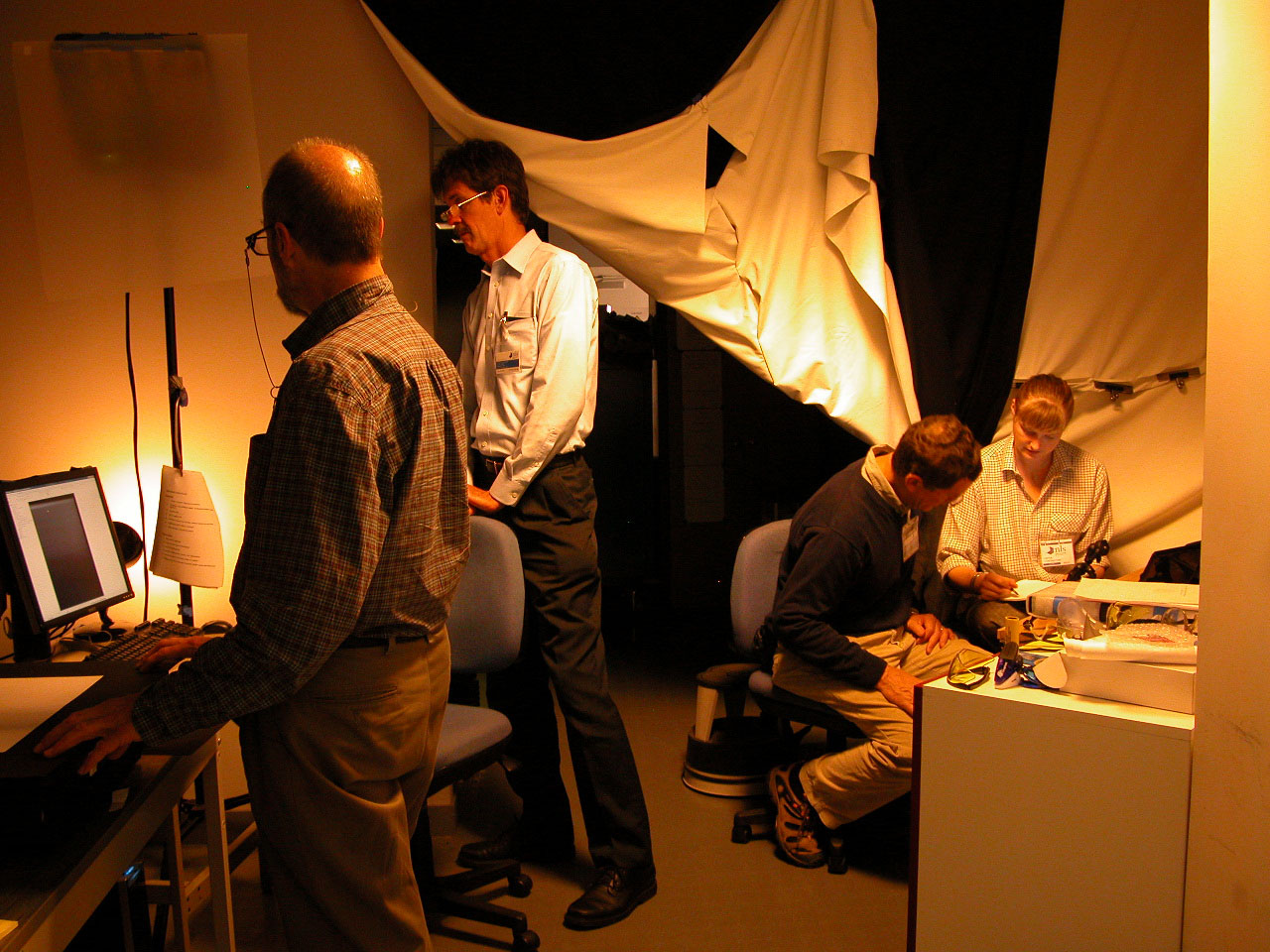
Members of the Livingstone Spectral Imaging Project team (Ken Boydston, Michael B. Toth, Bill Christens-Barry, Kate Simpson) moments before the initial spectral imaging of the 1871 Field Diary at the National Library of Scotland, Edinbrugh, 2010. Copyright Livingstone Spectral Imaging Project team. Creative Commons Attribution-NonCommercial 3.0 Unported. The edge of the copy-stand is just visible in the foreground left. The 'blackout' lining curtain, partly pulled up, appears in the background.
The Livingstone team transported the EurekaVision™ spectral imaging system from the U.S. and set up the system during the first two days of the imaging sessions. The EurekaVision™ system, a state-of-the-art image capture system, maximizes the information recorded with minimum impact on the historical documents. MegaVision’s PhotoShoot™, the software that powers the system, is designed to ease user tasks such as image sequence setup, imaging parameter entry, focus and image inspection, collection and organization of metadata, and image conversion and storage.
| (Left; top in mobile) Adrian S. Wisnicki and Debbie Harrison discuss a page of the 1871 Field Diary during the spectral imaging of the diary at the National Library of Scotland, Edinbrugh, 2010. (Right; bottom) Karen Carruthers examines a leaf of the 1871 Field Diary, while Ken Boydston operates the workstation in the background during the spectral imaging of the diary at the National Library of Scotland, Edinburgh, 2010. Copyright Callum Bennetts - Maverick Photo Agency. Used by permission. |
The components transported by the team to Edinburgh included:
1) monochrome MegaVision E6 39 megapixel camera back (7216 X 5412 pixels; 16-bit data with approximately 12 bits of dynamic range) mounted in a technical view camera with a 60mm UV-VIS-IR lens and a color filter wheel installed for UV fluorescence studies.
2) light-emitting diode (LED) illumination panels which were placed on tripods on either side of the copy stand in symmetric downward-looking positions angled approximately 45º on either side. The team also used diffusers to create uniform and nondirectional light fields. Raking illumination was provided in two spectral bands from either side of the manuscript.
3) modified desktop computer that controlled the imaging system using MegaVision’s PhotoShoot™ 4.0 software. This software orchestrated the operation of both camera and lighting through FireWire and USB connections, respectively.
| Two images of the LED illumination panels used for the spectral imaging of the 1871 Field Diary at the National Library of Scotland, Edinburgh, 2010. Copyright Livingstone Spectral Imaging Project team. Creative Commons Attribution-NonCommercial 3.0 Unported |
Each LED panel contains seven banks of LEDs that emit in the ultraviolet (1 wavelength) and visible regions (6 wavelengths) of the spectrum and five additional clusters of LEDs that emit in the infrared region (5 wavelengths). The geometry of the LED light panels is designed to provide maximum uniformity of the illumination at the surface of a leaf being imaged. A primary advantage of the system is that LEDs do not generate heat that can damage fragile pages. In addition, illumination from a low “raking” angle enhances the visibility of surface height variation, yielding images in which impressions or surface relief features are enhanced.
The EurekaVision™ system illuminated each Livingstone folio with twelve bands of wavelengths of light from the ultraviolet (UV) through the visible and the infrared (IR):
Band = Wavelength in nanometers
01 = 365 (UV)
02 = 450
03 = 465
04 = 505
05 = 535
06 = 592
07 = 638
08 = 700 (near IR)
09 = 735 (near IR)
10 = 780 (near IR)
11 = 850 (near IR)
12 = 940 (near IR)
The monochrome camera automatically photographed the folio under each illumination, with the raw image data stored on an external hard drive attached to the desktop computer. In addition, the team used four raking lights (lights that illuminate the folia at an oblique angle and so highlight page topography) mounted within separate panels and on separate tripods when imaging folia that had not been laminated, as follows:
Band = Wavelength in nanometers
13 = 940RR (IR raking right)
14 = 465RR (blue raking right)
15 = 940RL (IR raking left)
16 = 465RL (blue raking left)
The team chose to use a monochrome camera, without color or infrared filters, because doing so allows: 1) lower light levels for illumination, 2) no interpolation or preprocessing of the filtered image, minimizing collection artifacts, and 3) unfiltered light from all spectral bands to reach the camera sensor. Such a camera yields very pure, high-resolution, registered images of each spectral band and facilitates processing not only for text enhancement, but also for very accurate color reproduction.
Download a set of curated Imaging Set-Up project documents
▲ Data Logging, Collection, and Copying. The camera operator and the data logger collaborated in running the EurekaVision™ system, while a representative of the NLS or the NTS handled the primary documents and set and flipped them on the copy stand. A variety of locally-recruited personnel took part in the camera operation and data logging, including Anne MartinAnne Martin (David Livingstone Centre). Institutional contact for the multispectral critical edition of Livingstone's 1871 Field Diary. (DLC), Karen Carruthers (DLC), Suzanne Lamb (NTS), Alison MetcalfeAlison Metcalfe (National Library of Scotland). Institutional contact for the multispectral critical edition of Livingstone's 1871 Field Diary. (NLS), and Kate SimpsonKate Simpson (Edinburgh Napier University). Research assistant for the multispectral critical edition of Livingstone's 1871 Field Diary. (Edinburgh Napier University). Several Livingstone team members also actively participated. The process required constant rotation of personnel due to the long hours, continuous concentration required, and complexity of the data to be logged.
| (Left; top in mobile) Michael B. Toth trains Kate Simpson in data logging during the spectral imaging of the 1871 Field Diary at the National Library of Scotland, Edinburgh, 2010. (Right; bottom) Kate Simpson trains Anne Martin in data logging during the spectral imaging of the 1871 Field Diary at the National Library of Scotland, Edinburgh, 2010. Copyright Livingstone Spectral Imaging Project team. Creative Commons Share-alike 2.5 UK: Scotland. |
To ensure the team captured accurate metadata about the objects and images, data manager Doug EmeryDoug Emery (Emery IT). Data manager for the multispectral critical edition of Livingstone's 1871 Field Diary. developed the Multispectral Imaging Metadata Machine, or MSIMM (pronounced "Miss M."), which powered data logging. As each document came up for imaging, the data logger located the document in the MSIMM database and read off the file name to the system operator who entered it into MegaVision’s PhotoShoot™. The data logger, in turn, noted any unusual features of the document or exceptional imaging circumstances (such as a reshoot due to previous interruptions) in the log. Once data had been entered, all personnel put on UV protective glasses, turned off the room lights, and the capture of the image set began. Each capture lasted about two minutes, with times slightly extended when raking lights were used. During capture no one could pass through the dark room because the data could be compromised and because individuals without appropriate eye protection could be injured by UV light.

Suzanne Lamb and Karen Carruthers examine an unmarked copy of the 24 November 1869 issue of The Standard held by the National Library of Scotland, Edinburgh, 2010. Copyright Livingstone Spectral Imaging Project team. Creative Commons Attribution-NonCommercial 3.0 Unported
The desktop computer powering the imaging system also collected the raw image data to an external hard drive. For each image, the system produced an image set of either twelve registered images or sixteen if the raking lights were used. Periodically, team members replaced the hard drive containing the raw data and took it away for copying, a task which constituted a full-time job in itself. Team members copied the raw data to other external hard drives brought by the team and transferred files externally via FTP overnight to a designated site. This distribution strategy helped prevent the loss of data and made the data available to scientists onsite (EastonRoger L. Easton, Jr. (Rochester Institute of Technology). Imaging scientist for the multispectral critical edition of Livingstone's 1871 Field Diary., Christens-BarryBill Christens-Barry (Equipoise Imaging, LLC). Imaging scientist for the multispectral critical edition of Livingstone's 1871 Field Diary.) and overseas in Hawaii (KnoxKeith Knox. Imaging scientist for the multispectral critical edition of Livingstone's 1871 Field Diary.) for validation, assessment, and initial processing. The strategy also enabled EmeryDoug Emery (Emery IT). Data manager for the multispectral critical edition of Livingstone's 1871 Field Diary. to review the data and metadata for quality and provide updates to the metadata records and software. As a result, the Livingstone Spectral Imaging Project was able to operate twenty-four hours a day during this period.
▲ Personnel and Activities. The Livingstone team spent a week and a half in Edinburgh (18 June, then 24 June to 3 July 2010). Team members arrived and took part in activities according to the following schedule:
| Date | Activity | Folia Imaged by Shelfmark* | Personnel** | External Visitors |
| 18 June, Fri | site survey | Christens-Barry, Easton (en route to other work in Europe) | ||
| 24 June, Thur | site survey / initial set-up | Wisnicki | Suzanne Lamb (NTS) | |
| 25 June, Fri | complete set up / initial imaging | MS. 10701, MS. 10707, MS. 10768, 1120b | Wisnicki, Toth, Boydston, Simpson | |
| 26 June, Sat | imaging | 297c, 297b, 297e | Wisnicki, Toth, Boydston, Easton, Simpson | |
| 27 June, Sun | ||||
| 28 June, Mon | imaging | MS. 10703, 297d | Wisnicki, Toth, Boydston, Easton, Christens-Barry, Simpson | Anne Martin (DLC) |
| 29 June, Tue | imaging | MS. 10703, 297a | Wisnicki, Toth, Boydston, Easton, Christens-Barry, Simpson | Karen Carruthers (DLC), Ian Riches (NTS), John Sinclair (NTS), Suzanne Lamb (NTS) |
| 30 June, Wed | imaging | 297a, MS. 10703, [MS. 72.1.1] | Toth, Boydston, Easton, Christens-Barry, Simpson | |
| 1 July, Thur | imaging | 297e, 1120b, MS. 10701, MS. 10768, 297c, [MS. 42237] | Wisnicki, Harrison, Toth, Boydston, Easton, Christens-Barry, Simpson | Karen Carruthers (DLC) |
| 2 July, Fri | imaging | [MS. 43325], [MS. 43327], [MS. 43408] | Wisnicki, Harrison, Toth, Easton, Christens-Barry, Simpson | |
| 3 July, Sat | pack up equipment | Toth, Easton, Christens-Barry | ||
| * Folia marked with square brackets are non-Livingstone manuscripts imaged at the request of the NLS. ** For full names of personnel, see the project team page. |
||||
In addition, the team received regular assistance from NLS staff, including Alison MetcalfeAlison Metcalfe (National Library of Scotland). Institutional contact for the multispectral critical edition of Livingstone's 1871 Field Diary., Rab Jackson, George Morrison, Kate Kidd, and Sally Todd.
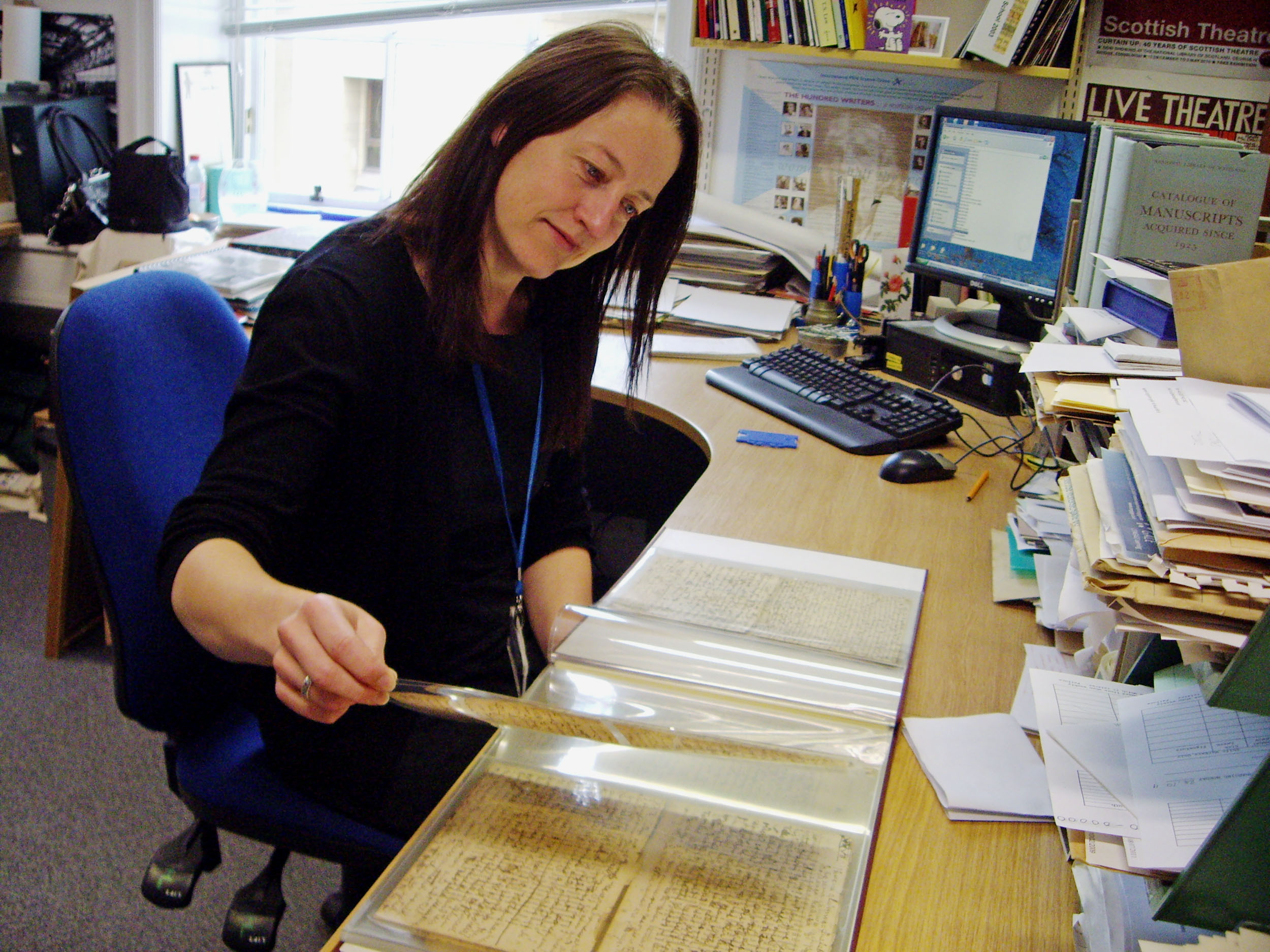
Alison Metcalfe looks over the pages of the 1870 and 1871 Field Diaries held by the National Library of Scotland, Edinburgh, 2011. Copyright Livingstone Spectral Imaging Project team. Creative Commons Attribution-NonCommercial 3.0 Unported
During the sessions, WisnickiAdrian S. Wisnicki (Indiana University of Pennsylvania). Director, lead scholar, and principal writer for the multispectral critical edition of Livingstone's 1871 Field Diary. also took a day off (30 June) to travel up to Aberdeen where he met with historian Roy Bridges. Professor Bridges’s pioneering studies of the manuscripts of Victorian explorers of Africa – Livingstone in particular – had provided one of the key inspirations for Wisnicki to take forward his work on the diary. The visit allowed Wisnicki to meet Professor Bridges and describe the objectives of the spectral imaging project. Professor Bridges, in turn, furnished Wisnicki with a number of articles and other items – many of them unpublished – that would be useful to Wisnicki’s research on the 1871 Field Diary.
▲ Imaging Schedule and Objectives. In planning for the spectral imaging sessions, the team allowed for two different scenarios. Imaging the DLC folia under the identifiers 297b and 297c (Livingstone 1871f), the core of the 1871 Field Diary, would take up the whole time in the worst-case scenario. Livingstone had used his improvised red ink on these folia. The newspaper pages over which he wrote had deteriorated over time. The pages had been laminated with a heat-set document repair tissue, a factor that compromised legibility and had the potential to impede spectral imaging and processing. Finally, the average page size (10 x 12 inches) suggested that each would have to be imaged in two segments and imaging time would be doubled if the imaging conditions at the NLS were not ideal.
| (Left; top in mobile) A sample of an 1871 Field Diary page laminate at 6.6x magnification and (center; right/bottom in mobile) two comparative samples of an 1871 Field Diary page laminate (above) and another laminate (below) at 1.2x magnification. Copyright Livingstone Spectral Imaging Project team. Creative Commons Attribution-NonCommercial 3.0 Unported. The project team is grateful to Fenella France (Library of Congress) for producing these images for this edition. |
None of these issues would emerge in the best-case scenario. Imaging of the 297b and 297c (Livingstone 1871f) folia would proceed smoothly, without any compromise in quality, and the team would have time to image at least a portion of the additional manuscript pages. There was reason to hope for this scenario. The team had collected a small sample of the laminate on 297b and 297c (Livingstone 1871f) in October 2009. Subsequent comparative analysis by Fenella France, Research Chemist at the U.S. Library of Congress (LoC), using another sample at the LoC with a known spectral response helped the team understand some focus issues associated with imaging laminated documents. In addition, EastonRoger L. Easton, Jr. (Rochester Institute of Technology). Imaging scientist for the multispectral critical edition of Livingstone's 1871 Field Diary. had processed some of the low-resolution, unregistered spectral images collected in October 2009, and the results were promising. Finally, in Scotland the team could also draw on the experience of working with the Letter from Bambarre.
| Low-resoluation natural light and two processed PCA spectral images of a page of the 1871 Field Diary (Livingstone 1871f:CLX), detail. Copyright David Livingstone Centre, Blantyre. As relevant, copyright Dr. Neil Imray Livingstone Wilson. Creative Commons Attribution-NonCommercial 3.0 Unported. These are the low-resolution 'raw' and processed spectral images resulting from the team's initial visit to the David Livingstone Centre in October 2009. |
As a result, the team balanced the schedule and cost risks and set their sights on the best-case scenario, a highly desirable outcome given the effort and expense involved in coordinating schedules, securing permissions, arranging facilities, and bringing equipment and personnel to Scotland. As a test run, the team spent most of the first imaging session (24 June) on letters and diary pages composed with the same materials as the Letter from Bambarre or with the same ink as the 1871 Field Diary. The experiment proved a full success, with no issues coming into play, so on the second day, a Saturday, the team moved to the 297b and 297c (Livingstone 1871f) folia. Again, none of the anticipated issues arose, and the team not only completed the entire run of these folia, but also those of DLC297e. This development put the team five days ahead of schedule.

Members of the Livingstone Spectral Imaging Project team (Michael B. Toth, Ken Boydston, Roger L. Easton, Jr., Adrian S. Wisnicki) after climbing Arthur's Seat in Edinburgh, 27 June 2010. Copyright Livingstone Spectral Imaging Project team. Creative Commons Attribution-NonCommercial 3.0 Unported. Having just moved five days ahead of schedule, the members of the project team were in a rather jubilant mood.
The team moved to additional DLC and NLS pages in the following days. By capturing these images, the team ultimately doubled its anticipated results and laid the groundwork for the next phase of the project, a multispectral critical edition of Livingstone's 1870 Field Diary and select 1870-71 manuscripts, at no added cost. In fact, the team ran so far ahead of schedule that they concluded the imaging sessions by spectrally imaging a number of sample manuscript folia at the request of the NLS. These included two folia from a Gaelic 1467 manuscript by Dubhghall Albanach mac mhic Cathail (file prefix MS. 72.1.1), a few letters from Lord Byron (MS. 43325, MS. 43327, and MS. 43408), and the entire text of Sir John Franklin’s 1821 Field Diary (MS. 42237).

Adrian S. Wisnicki examines a page of the 1871 Field Diary during the spectral imaging of the diary at the National Library of Scotland, Edinburgh, 2010. Copyright Callum Bennetts - Maverick Photo Agency. Used by permission.
The success and scope of this spectral imaging effort, therefore, which depended on a combination of foresight, preparation, team discipline, risk management, and luck, represents one of the major accomplishments of the Livingstone Spectral Imaging Project.
Download a set of curated Imaging Schedule and Objectives project documents



![Processed spectral image of a page from Livingstone's 1871 Field Diary (Livingstone 1871k:[5] pseudo_v1), detail. Copyright David Livingstone Centre and Dr. Neil Imray Livingstone Wilson: CC BY-NC 3.0 Processed spectral image of a page from Livingstone's 1871 Field Diary (Livingstone 1871k:[5] pseudo_v1), detail. Copyright David Livingstone Centre and Dr. Neil Imray Livingstone Wilson: CC BY-NC 3.0](https://livingstoneonline.org:443/sites/default/files/section_page/carousel_images/liv_013723_0001-new-carousel_0.jpg)



![Processed spectral image of a page from David Livingstone's "Retrospect to be Inserted in the Journal" (Livingstone 1870a:[3] pseudo_v4_BY), detail. Copyright National Library of Scotland and Dr. Neil Imray Livingstone Wilson: CC BY-NC 3.0 Processed spectral image of a page from David Livingstone's "Retrospect to be Inserted in the Journal" (Livingstone 1870a:[3] pseudo_v4_BY), detail. Copyright National Library of Scotland and Dr. Neil Imray Livingstone Wilson: CC BY-NC 3.0](https://livingstoneonline.org:443/sites/default/files/section_page/carousel_images/liv_000211_0003_pseudoBY_940_by_592-carousel.jpg)

![David Livingstone, Map of Central African Lakes, [1869], detail. Copyright National Library of Scotland: CC BY-NC-SA 2.5 SCOTLAND and Dr. Neil Imray Livingstone Wilson: CC BY-NC 3.0 David Livingstone, Map of Central African Lakes, [1869], detail. Copyright National Library of Scotland: CC BY-NC-SA 2.5 SCOTLAND and Dr. Neil Imray Livingstone Wilson: CC BY-NC 3.0](https://livingstoneonline.org:443/sites/default/files/section_page/carousel_images/liv_003006_0001-new-carousel_0.jpg)
